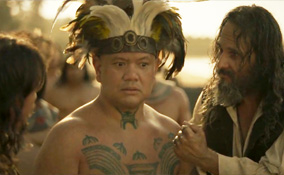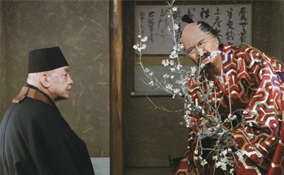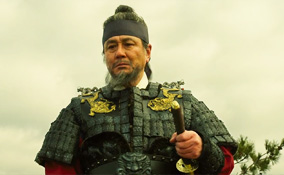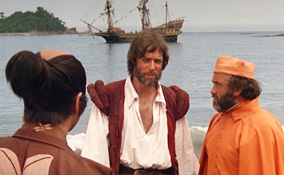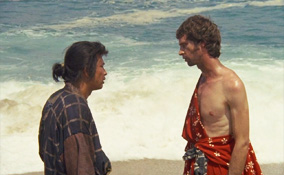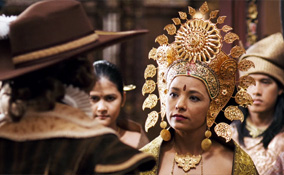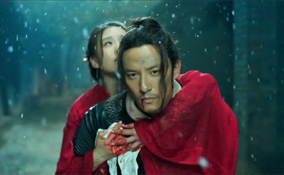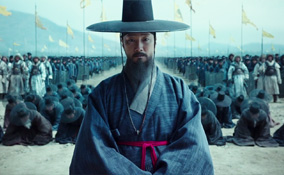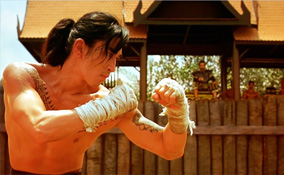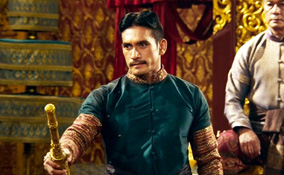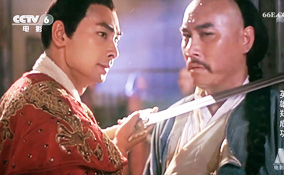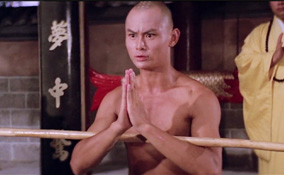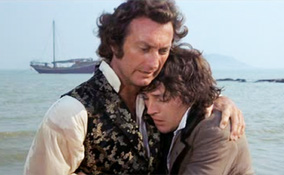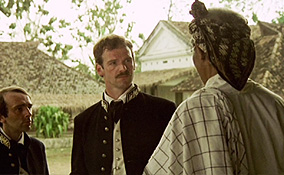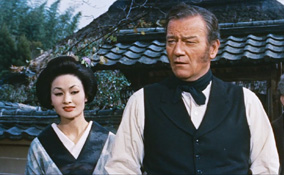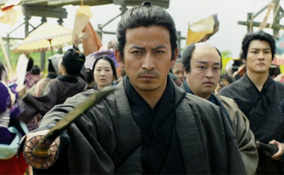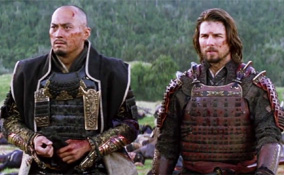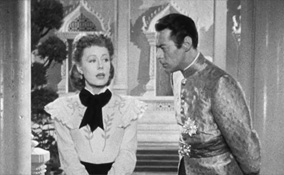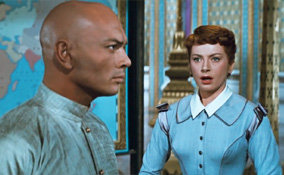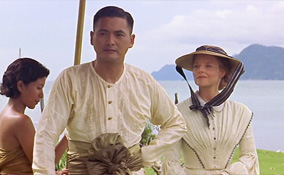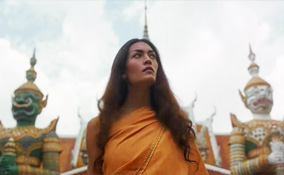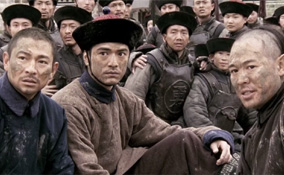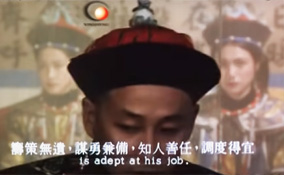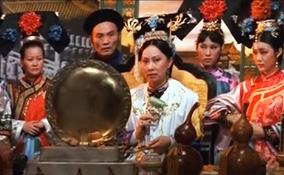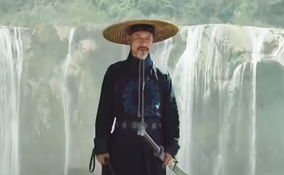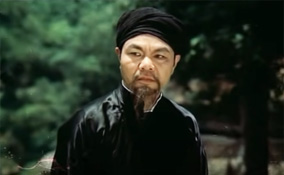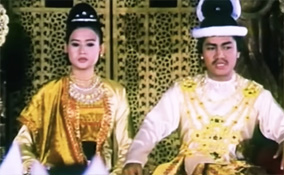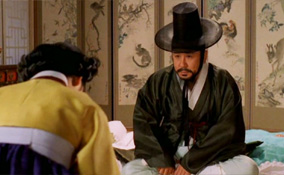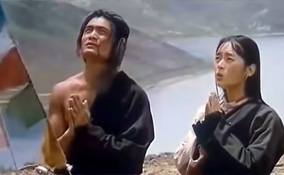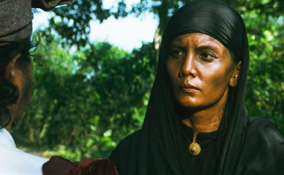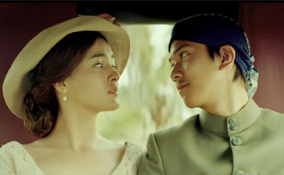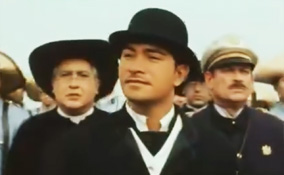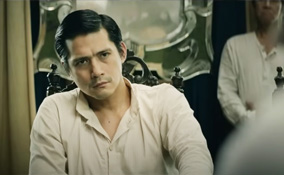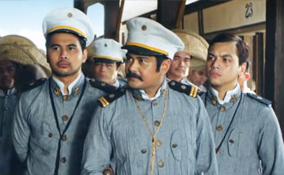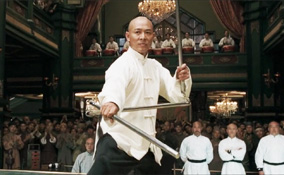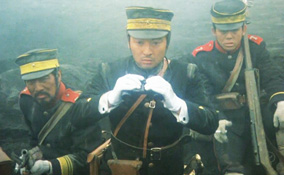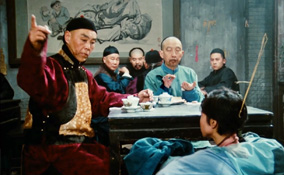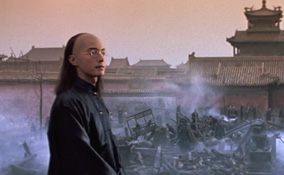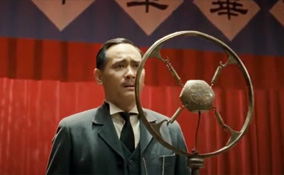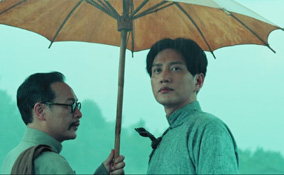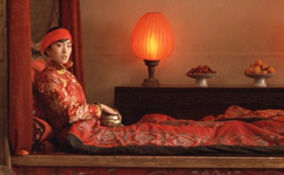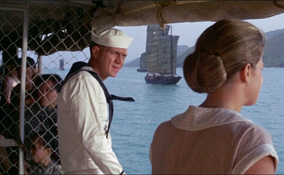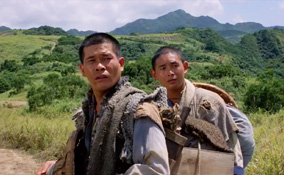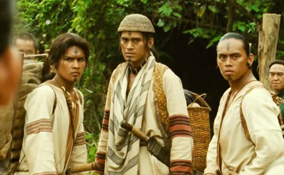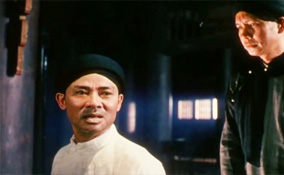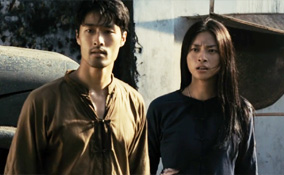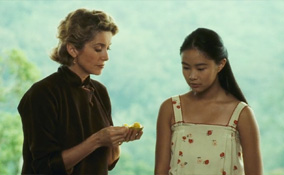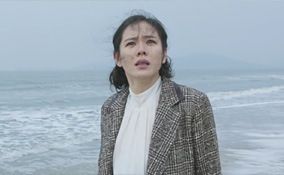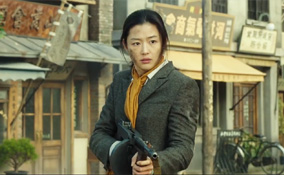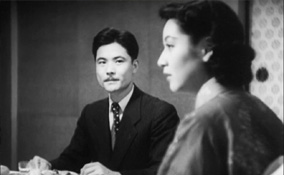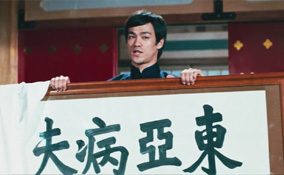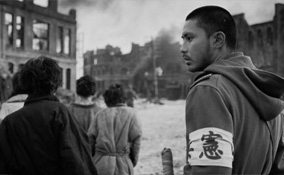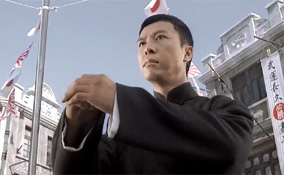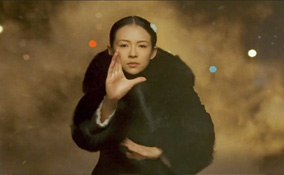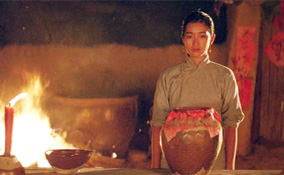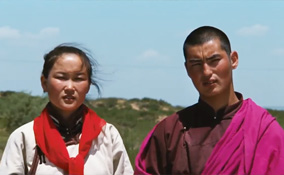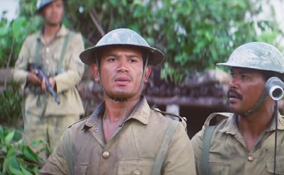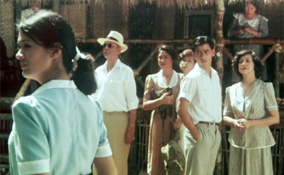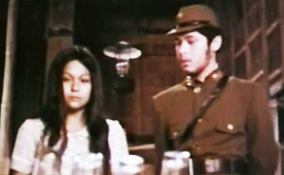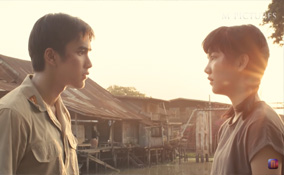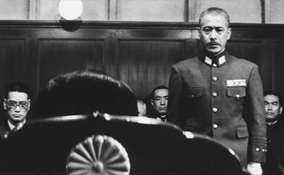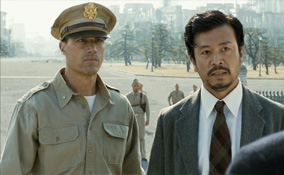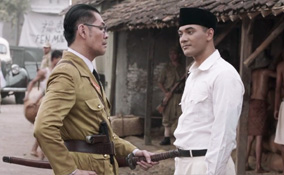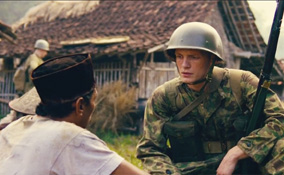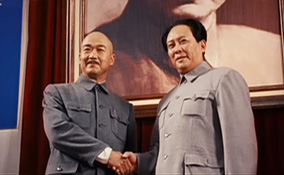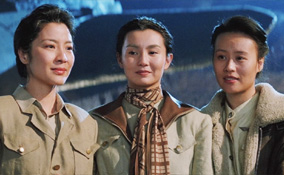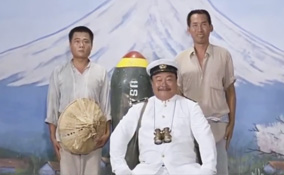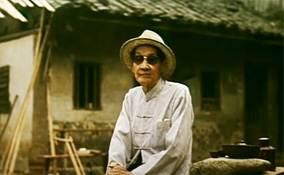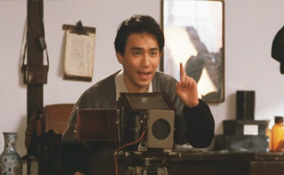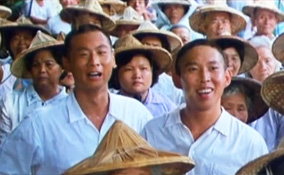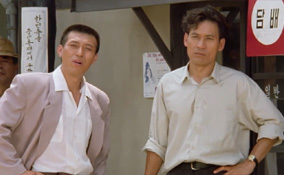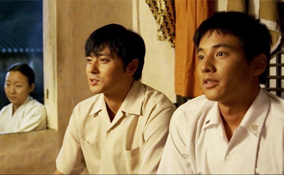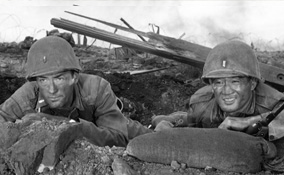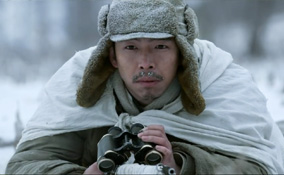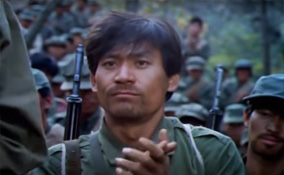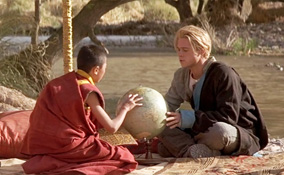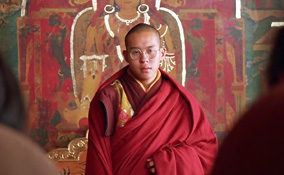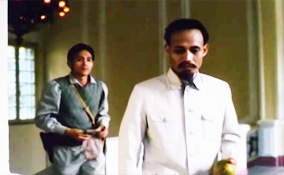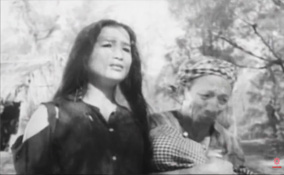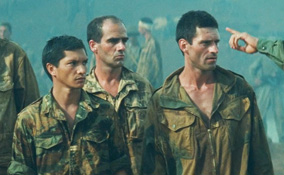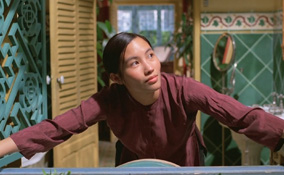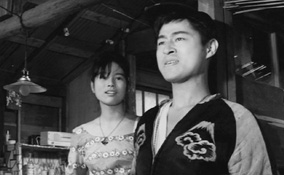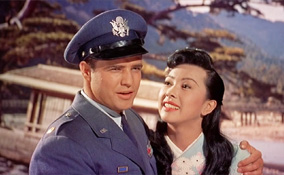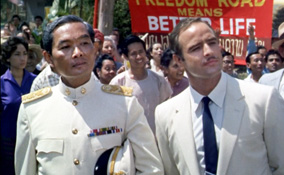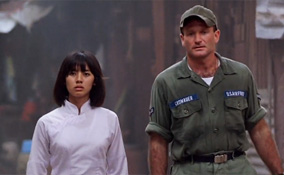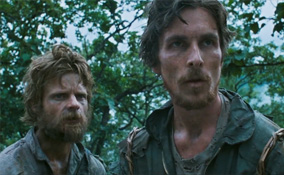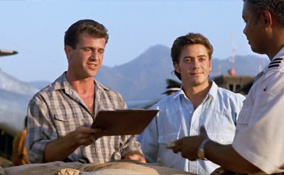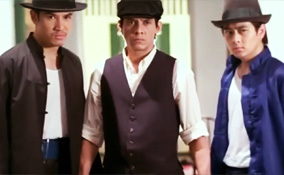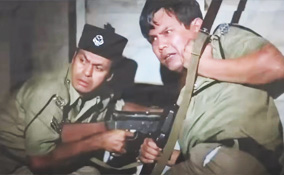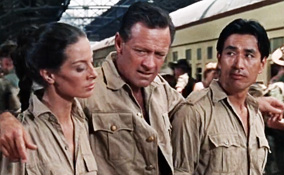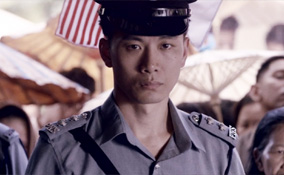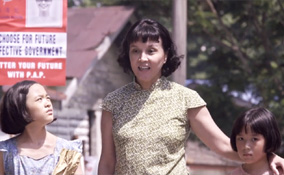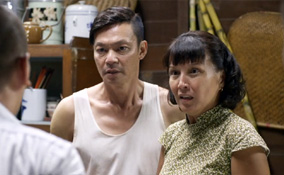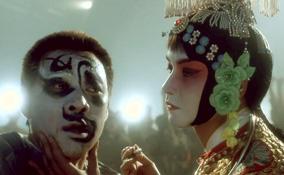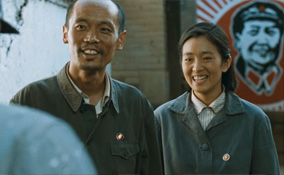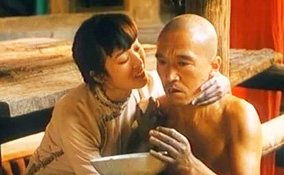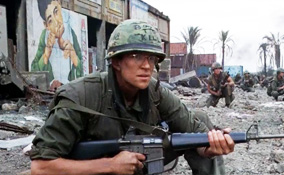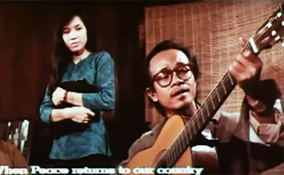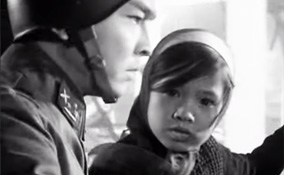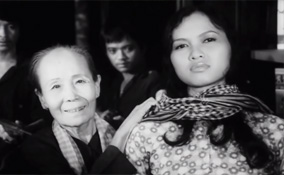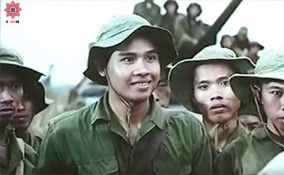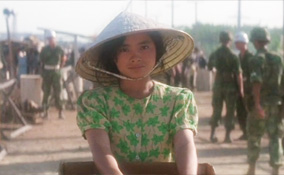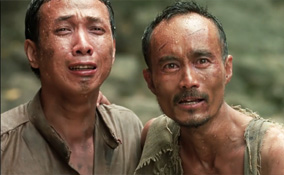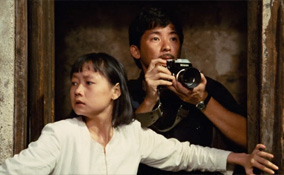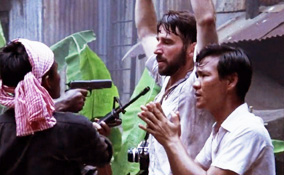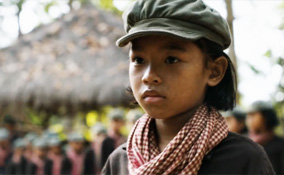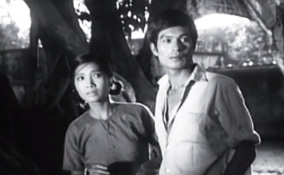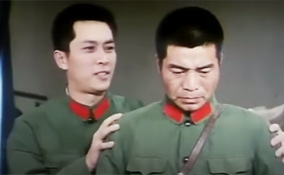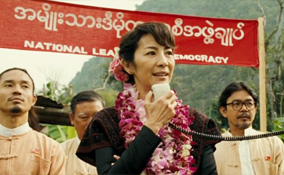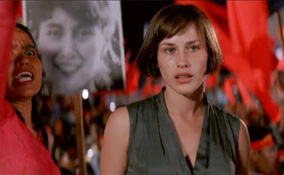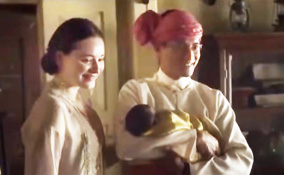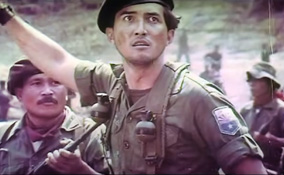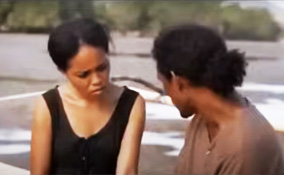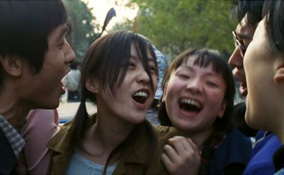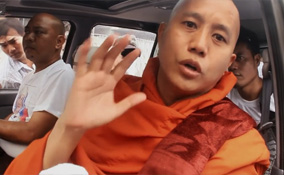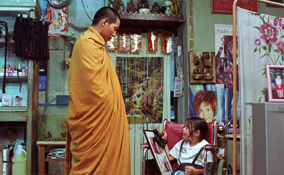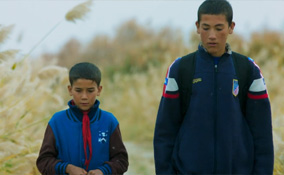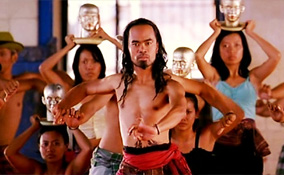<<< II
Notes on films about colonialism in Asia (2): Java to China
Early sixteenth century East Asia and Southeast Asia saw numerous kingdoms already prospered, with China as the most powerful empire in the region. China formed tributary system with smaller kingdoms from Korea to Siam. In smaller scale, major powers in Southeast Asia also formed similar tributary system to numerous smaller kingdoms in the region. The arrival of Western powers and their weapons would eventually disrupt these patterns.
Year 1519, Ferdinand Magellan, a Portuguese explorer commanded a flotilla of ships armed by the Crown of Spain in search of an alternative way to the spice islands (Moluccas Islands, present-day Indonesia) via South America, by sailing round the southern tip of the American continent to reach the Pacific Ocean. They will face hostile South American natives, spies, mutinies and hopelessness until they eventually find the passage to the South Sea (Pacific Ocean). Told totally from perspectives of European crews on the ships with Portuguese as villain, this Spanish series Boundless (2022, Spain)** could have been better but instead chose to be Spain's nationalist one. The death of Magellan who was Portuguese, in the island of Cebú (present-day Philippines) while he combated rebellious natives, gives way to glorify heroism of Spanish crew, Juan Sebastián Elcano, who successfully led the fleets to Moluccas Islands, and completed the route around the globe back to Spain for the first time in history in 1522. The Battle of Mactan in 1521 that killed Magellan was led by Lapu-lapu, who consequently became Philippines national symbol of resistance to colonialism. There are at least two Filipino films about this hero: Lapu-Lapu (1955) and Lapu-Lapu (2002). But unfortunately, I couldn't find any decent copy with English subtitles for these films. I may update later.
Since 1192 in Japan, a powerful daimyo (feudal lord)
Minamoto Yoritomo established feudal system where the emperor's role was restricted, and the daimyo became the first shogun ruling Japan. But the system was collapsed during civil war (Onin War 1467-1468) creating power vacuum resulting in period of power struggle between daimyos in many regions while shoguns became their puppets (and emperors were still merely spiritual symbol.) By 1568, a daimyo named Oda Nobunaga started the unification of Japan which would be completed later by his successors
Toyotomi Hideyoshi and
Tokugawa Ieyasu. Established after the coup in 1392, Joseon dynasty (ราชวงศ์โชซ็อน) needed justification for its rule given the lack of a royal bloodline. To get recognition by Imperial China, Joseon became the tributary state (รัฐบรรณาการ) that paid tribute to China, in return for access to the huge Chinese market. While Japan suspended tribute missions to China in 1408, China considered the invasion of Joseon in 1592 as a threat to the Imperial Chinese tributary system. China entered into the conflict by sending reinforcements to attack from the north combining with guerrilla warfare by Joseon's civilian-led armies, and successfully prevented Japan to conquer Joseon in 1596. ... During 1597 Second Japanese invasion of Joseon the legendary Joseon admiral Yi Sun-sin managed to destroy 31 of 133 Japanese warships with only 13 ships remaining in his command, preventing the Japanese to invade the capital. The Admiral: Roaring Currents (2014, Han-min Kim, South Korea)** is uncomplicated patriotic war film about national hero in very limited event that unfortunately doesn't provide realistic explanation about how Joseon managed to survive this war.
It also completely omitted Chinese role in this conflict.
Loosely based on a real-life English adventurer William Adams in late sixteenth century Japan, Shogun (1980)*** tells story a fictional English sailor John Blackthorne who arrives in 1600 Japan on a Dutch ship living through the civil war between two daimyo for the title of "Shogun". This TV series begins after the death of Toyotomi Hideyoshi and ends with the rise of Tokugawa Ieyasu who is fictionalized here as Lord Yoshi Toranaga. It also addresses the Treaty of Saragossa (1529) where Spain and Portugal divided the world with the blessing of the pope. Here Portuguese Jesuits and Spaniards (Catholics) are villains to the English hero (Protestants) reflecting political climate in Europe at that time which is main point of the series, as well as the political conflict in Japan. Though fictionalized, Shogun made it clear that the threat of European colonialism will be responsible for massacres of Japanese Christians in the years to come. Driven by crisis of Catholicism in Europe, the Church
sought
to expand its belief to places outside. The Portuguese Jesuit priest Francis Xavier arrived in Japan by 1549.
30 years later, there were more
than 200 churches,
75 priests and 300,000
believers making
Japan's rulers
worried about the new
religion's rapid spread,
since it came with the gun.
Japan's persecution of Christians started in the late 1500s, and the religion was ultimately banned in 1614, though some Japanese Christians continued to practice their religion in secret. Countless Jesuit priests and
believers were killed, tortured and disappeared.
The Tokugawa Shogunate which would rule Japan for 264 years, viewed Christianity as a threat to the stability of its rule. This religious persecution resulted in the Shimabara Rebellion (1637–1638), an uprising of Japanese Roman Catholics that deepened the shogunate's distrust of foreign influence. When the rebellion was put down, Japan decided to close country from the outside world (known as sakoku policy), except for the Dutch merchants (Protestants) at a small port of Nagasaki who continued supplying technological knowledge that would slowly modernize Japan behind closed border.
Sultan Agung (2018, Hanung Bramantyo, Indonesia)** [Netflix Thailand] tells story about Sultan Agung of Mataram in Central Java ruling from 1613 to 1645. He expanded territories and tried to unite all kingdoms on the island of Java under his reign. So it's inevitable that he would face Dutch troops who had conquered Jacatra (now Jakarta) in 1619 and established there a base they named Batavia. This is a fine patriotic movie with large battle scene when Mataram forces attacked Batavia in 1628. Though the attempts failed to drive the Dutch out of Java, Sultan Agung is considered as a national hero in present-day Indonesia. During his reign, arts and cultures were established with combination of Hinduism, Buddhism and Islam. However the ending of this war-film is quite unexpected with celebration of Islamic values, as Mataram/Indonesia moved toward fundamental Islamic kingdom. Langkasuka 1593, the Great Cannons made by a Dutchman, and its know-how, stir up conflicts between kingdoms in Malay Peninsula. Heavily inspired by Chinese wuxia genre, Queens of Langkasuka (2008, Nonzee Nimibutr, Thailand)** [watch] [Netflix Thailand] is a fantasy film based on some real historical characters involving a Hindu-Buddhist kingdom located in area of present-day Southern Thailand. The film feels too rush to cover the first book of two-volume novel by Win Lyovarin, which its story can be quite unique, but unfortunately Queens of Langkasuka lacks of its own distinctive style resulting in a mediocre action film in the look of faux Waterworld. The message in the end is also not clear after the battle between Western technologies (learned by a Chinese) versus native ancient magic.
China 1620s, the
Ming dynasty (ราชวงศ์หมิง) was in declining state while the Manchus conquered Northeastern territory, and the Dutch
occupied the island of Taiwan. The imperial government was also exploited by the infamous eunuch, Wei Zhongxian (เว่ย์ จงเสียน) who was considered the most powerful eunuch in Chinese history. In 1636, the Manchus started invading Joseon and were in conflict with Ming China. Joseon's king Injo took refuge in the fortress in Namhan Mountain. Told totally from Joseon perspective, The Fortress (2017, Hwang Dong-hyuk, South Korea)** depicts the failure of Joseon army to resist the barbaric Manchus, that gradually destroys hope of soldiers, people and audience. Joseon's bad governance is demonstrated here intensively and annoyingly. The powerful ending concludes this film as depressive portrayal of a nation losing the war, and the king was painfully subjected to the foreign emperor.
From 1569 to 1584, Ayutthaya Kingdom (Siam/Thailand) was a vassal state of Toungoo Dynasty (Burma/Myanmar), but quickly regained independence by King Naresuan the Great (r. 1590-1605). While in Japan, power struggle between warlords after the death of Toyotomi Hideyoshi in 1598, and persecutions of Japanese Christians by the Tokugawa Shogunate had driven Japanese people to leave Japan for other countries, so as Yamada Nagamasa who arrived at Ayutthaya in early 17th century. The Japanese colony in Siam at that time was highly valued for its military expertise, and was organized as Japanese volunteer army serving the King of Ayutthaya. Yamada Nagamasa who was the head of the colony would later become the influential governor of Nakhon Si Thammarat province. But after the death of King Songtham in 1628, Ayutthaya descended into bloody succession war. Nagamasa led the Japanese troops to crush the rebels. But after the coup by who would reign as King Prasat Thong, the new king ordered to kill Nagamasa in 1630, and then expelled the remaining Japanese out of the kingdom. Informed by the news, the Tokugawa Shogunate terminated relationship with Ayutthaya, just before its sakoku policy. The Dutch took advantage of the Japanese withdrawal, increasing their trade and offering naval support. Ayutthaya soon emerged as an entrepôt of international trade and its cultures flourished. Forty-five years later, a Greek adventurer Constantine Phaulkon arrived at Ayutthaya during its golden age in 1675 after working for England's East India Company. He would climb up to be King Narai's favourite consultant. When the Dutch used force to exact a treaty granting them extraterritorial rights, Phaulkon advised the king to turn to France for assistance. His special status, and his alleged conspiracy with Louis XIV of France to conquer Ayutthaya, would stir the kingdom leading to rebels and assassinations. When pro-Western King Narai was on his deathbed in 1688, Phetracha (พระเพทราชา) staged a coup, killed designated heirs, executed Phaulkon, exiled French troops and missionaries, and closed the kingdom from the Western world. Except for the Dutch that was allowed to trade in the kingdom, Ayutthaya then saw the significantly rise in Chinese trade. It would enjoy its golden age into 18th century, and slowly declined until its fall by invasion of the Burmese Konbaung dynasty in 1767, ending the 417-year-old Ayutthaya Kingdom.
The Qing Empire conquered most of the territory of the fallen Ming dynasty, chased Ming loyalist regimes deep into the southwestern provinces. In 1645 they issued an edict ordering all Chinese men to shape the upper part of their scalps
and braid their remaining hair into a queue (ผมเปีย) resembling that of the Manchus to show their loyalty to the Qing Emperor. In the 1650s, the Qing Empire faced a resurgence of Ming loyalist resistance, leading by Zheng Cheng-Gong. Canton (Guangzhou), Qing China. A student fled from Qing soldiers to Shaolin temple expecting to learn martial skills there to fight the occupying Manchus. The 36th Chamber of Shaolin (1978, Liu Chia-Liang, Hong Kong)** is a classic kung-fu flick from British occupied Hong Kong, treating China as a Han Chinese country colonized by the Manchus. The story is basic revenge tale with realistic kung-fu scenes that take over most of its running time. Understandably recognized as iconic movie of the genre.
Released in 1997, the year Hong Kong returned to China, The Opium War (1997, Jin Xie, China)** [watch] opens in 1838 when Lin Zexu (หลินเจ๋อสวี) was given a task from the emperor to end illegal opium trading in Guangzhou, through the First Opium War, and ends with the ceding of Hong Kong to the British Empire in 1842. This film is surprisingly balanced between foreigners who interested only on money and power, and Chinese officers who blindly focused on honour and dignity - apart from bribe. Again bad governance is intensively demonstrated here in the film about the fall of the Middle Kingdom who once had esteemed itself as the center of the universe. The 1842 Treaty of Nanking opened the ports of Xiamen, Fuzhou, Ningbo, and Shanghai, ended China's isolationist policies (Haijin) enforced since Ming dynasty. This war is the beginning of what later known as China's century of humiliation (1839-1940s) that marks period China was exploited by foreign powers, and it also is the war that started series of conflicts forced other Asian kingdoms to submissively adopt their so-called free trade.
From the writer of Shogun, Tai-Pan (1986, Daryl Duke, USA)** fictionalizes the life of a British opium trader who was evicted out of Guangzhou by Lin Zexu in 1839, relocated to Macao and later to British Hong Kong in 1841. This expensive soap opera revolves around relationship between the protagonist and his son, his clichéd Chinese concubine, and his stereotypical archenemies during the foundation of Hong Kong. Tai-Pan is fairly entertaining but almost has nothing to do with China, including the last shot that cleverly symbolizes Hong Kong as the spirit of oversea British merchants.
Lebak 1850, Java, Dutch East Indies. Naive and reckless but with good intentions, a newly transferred idealistic Dutch officer tries to help poverty-stricken natives while surrounded by his brutal countrymen and corrupted native ruler (bupati). Adapting from an autobiographical book released in the Netherlands in 1860 that shook the Dutch Empire, Max Havelaar (1976, Fons Rademakers, Indonesia)*** is good historical film from perspective of the outcast of the Dutch. The real villain of the story is the joined bureaucratic system of the Dutch and local customs that acted as tyrannical oppression. The book raised the awareness of Europeans living in Europe at the time that the wealth they enjoyed was the result of suffering in other parts of the world. The story ends as a plea to King William III to take action about this abusive corruption in his colony. Born in British India, the British adventurer James Brooke arrived at the sultanate of Brunei on Borneo Island in 1839, and helped the sultan crushed the rebellion of Dayak tribes in Sarawak (present-day Malaysia). He was offered the governorship of Sarawak in return for his help. Unhappy with the white man, Malay nobles in Brunei plotted the murder of the prince who's closed to Brooke. With assistance from Britain's China Squadron, Brooke took over Brunei and restored its sultan to the throne. He was crowned the rajah of Sarawak in 1841 and ruled for 26 years successfully suppressing piracy, slavery and headhunting in the region. Brooke's dynasty had reigned until 1941 when Japan invaded Sarawak. After WWII, Charles Vyner Brooke decided that Sarawak should be ceded to Great Britain, he formally terminated Brooke rule on July 1, 1946. James Brooke's fascinating life inspired Rudyard Kipling's The Man Who Would Be King (1888) and Joseph Conrad's Lord Jim (1900).
Opens with the arrival of a Black Ship at the same time as Obon festival, John Huston's The Barbarian and the Geisha (1958)** tells story of the first US diplomat in Japan in 1856, and a geisha who was sent to live with him as a spy. When cholera (brought there by Westerners) attacks a village, the Americans decide to burn down the village to kill the disease, while Japanese try to protect their belongings holding on to their past. The film makes good arguments about modernization, though the reason to force opening of Japan described here still doesn't make sense to me. Affected by the arrival of the Black Ships, the Gunboat diplomacy and unequal treaties, the Tokugawa Shogunate faced backlash while the Emperor
gained momentum. This ideological-political divide escalated into major conflicts between the shogunate forces which including the elite Shinsengumi swordsmen, versus the pro-imperial nationalists. The latter was the leaders of the Meiji Restoration aiming to restore imperial rule to strengthen Japan against the threat of being colonized. This civil war ended in 1868 restoring practical rule to 14-year-old Emperor Meiji, and
officially eliminating the shogun, daimyos, and later, samurai.
Immortalized by modern technology like photography, these handsome samurai of Shinsengumi has been constantly romanticized in Japanese pop culture to present day. In a weird way, Taboo (1999, Nagisa Ôshima, Japan)** turns these historical poster boys into a bunch of queer samurai enchanted by the dangerous beauty of a pretty boy who might symbolize some dangerous ideas, new era, greed, or just death itself, threatening the elite squad which will soon be perished from history. As the Empire of Japan
continued modernizing
after the Meiji Restoration, the creation of the Imperial Japanese Army in 1873 by enlisting ordinary people made samurai force obsolete, combining with the prohibition on wearing swords in public in 1876 that destroyed status of the samurai, leading to the Satsuma Rebellion. The revolt was crushed in 1877 and effectively ended the samurai class. It was the last civil war fought in Japan.
Burma had been at war with the British since 1824. France invaded Vietnam in 1858. China lost the Second Opium War to the British and the French in 1860. In the reign of King Mongkut (1851–1868) of Chakri dynasty, Siam recognized the potential threat of Western powers, so his court contacted the British government directly to defuse tensions. The Bowring Treaty which was the first of many unequal treaties with Western countries, was signed in 1855. This, however, brought trade and economic development to Siam. God created the world in seven days as Anna Leonowens transforms the royal court of Siam in a week to impress the British ambassador and diplomats in the musical film The King and I (1956, Walter Lang, USA)**. While the 1946 film was made just after WWII and focuses on modernization of semi-barbarian country helped by a White woman in style of white savior narrative, the 1956 version was made ten years later and focuses on unconditional love and slavery as USA facing racial violence and the rise of civil rights movement in 1950s, at the beginning of the Cold War. Anna Leonowens stayed in Siam for 5 years during 1862-1867 which happened to be the same period as the American Civil War (1861-1865). The King and I deliberately adds the book of Uncle Tom's Cabin (1852) into the story and makes this film, which happens in Siam, being actually about the United States, and how they use their lessons to teach the world. Blatantly exaggerated to suit musical genre making the film a bit more offensive than the previous version, I find the 1946 film far superior, but this 1956 musical is much merrier.
Filmed mostly in Malaysia and banned in Thailand as other versions, Anna and the King (1999, Andy Tennant, USA)** is much more realistic though still far from authentic. It excludes many jokes used in those previous films making it more serious, and deliberately adds subplot about Siamese traitors who plans to a stage a coup against the peaceful King Mongkut, aiming to aggressively militarize Siam in the time of Western colonialism. Leonowens openly criticizes Western colonizers for the first time in this film and even makes some excuses for Siamese barbaric customs, reflecting how Hollywood's perception about the world has changed. While The King and I universally appeals as love story about a lady who finally tames a brutal guy who has many mistresses, Anna and the King is realistic Cinderella story of a single mom from Bombay and a wise king of a Buddhist country. In the end, she will literally save his life and his kingdom. The film is fairly okay, however, most Siamese characters speak pretty bad Thai language considering it was shot in Malaysia, the neighbor of Thailand, I guess this was intended to suit the way Chow Yun-fat speaks Thai. In response to Anna Leonowens' exaggerated memoir, a Thai writer Tommayanti wrote a fantasy novel named Tawiphop (1986), literally meaning two worlds, about a Western-educated and self-centered Thai woman who could transport back to feudal Siam through an ancient mirror. She will fall in love with a Thai aristocrat (wisdom of the past), he will love her back (modernization) and forced her to stay with him, because she is destined to help Siam during the threat of colonialism as translator and consultant since she knows about the future. The book ends beautifully with mother(s)-daughter relationship in both worlds symbolizing motherland.
|
||
On 6 October 1860, French and British troops captured the Summer Palace, looting and destroying the imperial collections over the next few days. On 18 October 1860, British soldiers burnt the palace, while the French refused to assist. Many artworks were looted and are now located in 47 museums around the world. In 1837, A Hakka Christian named Hong Xiuquan had a vision that he was a brother of Jesus Christ, and established the Heavenly Kingdom in southern China challenging the Qing dynasty. His fusion of Christianity, Daoism, Confucianism and indigenous millenarianism developed into a dynamic new Chinese religion called Taiping Christianity. At its peak the Taiping Rebellion (1850-1864) conquered almost half of Qing territory, it was one of the bloodiest civil war in China, the conflict resulted in approximately 20 to 70 million deaths in battles or from starvation.
The story of The Empress Dowager (1989, Han Hsiang Li, China)** [watch] happens during 1860s after Taiping Rebellion and the Second Opium War, until the death of the Tongzhi Emperor, Cixi's son, in 1875. Far from historically accurate, but this kind of TV drama is quite entertaining. And I'm surprised to see Gong Li in this little known film. After the sudden death of Ci'an in 1881, Cixi alone would rule behind two more emperors, who are her nephews, until her death in 1908. Star-studded The Empress Dowager (1975, Han Hsiang Li, Hong Kong)*** [watch] is bigger and better than 1989 film by the same director. It follows mainstream narrative where Cixi was the one who destroyed Qing dynasty. During 1890s Emperor Guangxu tried to enact reforms of a more Westernized government, but was opposed by the influential Cixi. By 1894, Japan invaded Korea and Manchuria in The First Sino-Japanese War with declining Qing China. The war ended in 1895 with China's defeat which would result in the beginnings of revolutionary movement that finally brought down the Qing dynasty in 1911. Due to its commercial success, the film also has a sequel called The Last Tempest (1976).
During the Sino-French War (1884-1885), French army annexed northern part of Dai Viet (Tonkin) into their colony, and invaded further into Guangxi province of Qing China. To Die with Honor (2017, Feng Gao, China)** [watch] follows General Feng Zicai who led Chinese army to fight the French until they finally retreated. This is a typical Chinese propagandistic film that is watchable but has nothing special. Hoàng Hoa Thám (1987, Vietnam)* [watch part one, two] was a Vietnamese feudal lord of Yên The in Northern Vietnam, and the leader of the Yên The Insurrection (1887–1913) that held out against French protectorate in Tonkin for 30 years. The insurrection collapsed with the murder of Hoàng Hoa Thám (known as De Thám) in 1913 by an agent working for the French. The surviving forces were scattered, ending one of the longest chapters of anti-French resistance in pre-modern Vietnam. The story of the film happens in 1890s when he met his third wife who will become the brain of the resistance. Not a good film.
In 1856, a massacre of Muslim
Hui people organized by a Qing Manchu official in Kunming, Yunnan province, sparked a province-wide multi-ethnic insurgency. In Dali City, an independent kingdom called
Pingnan Guo Sultanate was established. China finally suppressed the Panthay Rebellion in 1873 causing the deaths of up to a million people in Yunnan. Many Hui people fled with their families across the border to Burma and Siam (considering Laos was still under Siamese suzerainty at that time).
The Overture ( โหมโรง, 2004, Itthisoontorn Vichailak, Thailand)**** depicts two periods of life of a famous Siamese traditional musician that belong to two different political climates affecting traditional arts. During the reign of King Chulalongkorn (Rama V) in late 19th century, a young musician with his radical style paves his way into an elite band in a palace of a Siamese prince. And in 1942 Thailand during WWII, when the revolutionists' government joins Japan declaring war on the Allies, the aged protagonist faces the nationalist policies that aiming to modernize Thailand by promoting Western culture and arts, and abolishing traditional ones including traditional music which are considered uncivilized. While romanticizing life in feudal Siam and exploring life under Thailand's authoritarian regime, The Overture asks an important question for Asian countries under the threat of colonialism - if modernization could only be achieved by Westernization - and elegantly answers with that pivotal scene that will go down in history of Thai cinema as one of the greatest, when two generations of musicians beautifully harmonize traditional music instrument with newly arrived piano from Austria, resonating modernization in its own unique way. However, in my opinion, the film has peaked with that simple scene in the first hour, the following story is just extended part of the concept and inevitably weaker. Impressive patriotic film without using any foreign character as target.
The area covering today-Myanmar contained many kingdoms from many ethnic groups at that time with Burman kingdom as major power. Conflict between Burma and the British began when the Konbaung dynasty decided to expand into Arakan in British India leading to the First Anglo-Burmese War (1824–26) where the British Empire started annexing some parts in Southern Burma, until the Third Anglo-Burmese War in 1885 when the whole Burma became a province of British India. As a bustling international trading port in the 15th century Malay Peninsula, the Malacca Sultanate emerged as a centre for Islamic learning and encouraged the development of the Malay language, literature and arts. In 1511, Malacca was conquered by Portugal. The British East India Company established a trading post on Penang Island in 1786 and Singapura (Singapore) in 1819. In the 19th century, as various infighting among the Malay aristocracy
in the peninsula
threatened British economic interests in the region, the British began a policy of intervention by installing "residents" as advisors to the rulers, who soon became the de facto ruling powers of their states.
Painted Fire (2002, Im Kwon-taek, Korea)*** [watch] tells story of a gifted poor boy who will become the famous Korean painter, Jang Seung-up (1843-1897). He grew up during political turmoil when Joseon faced foreign invasions and internal rebellions. Surviving by copying famous Chinese paintings, the protagonist tries to create his own distinctive style liberating his works from Chinese influences. This internal battle of the artist is the core of this film. Refusing to reform, both Joseon and Qing China were pressed by modernized Japan, Painted Fire ends in 1897 when Joseon became nominally independent and declared the short-lived Korean Empire after 1895, before it was annexed as a part of the Empire of Japan in 1910 under the Japanese name Chosen. Though this is very beautiful film by Korean master, the ending is a bit underwhelmed since it made me wonder if the protagonist really finds the answer in the end, so as Korea. After conquering Burma in 1885, the British fears about a threat to British India from the north by Russia via Tibet. At that time Tibet ruled by the 13th Dalai Lama was a Himalayan state under the protectorate of the Chinese Qing dynasty. The British force, which consisted mostly of Indian troops, advanced into Tibet via Sikkim in 1903 and stayed there until September 1904 after received the agreements it desired.
After the Portuguese occupation of Malacca in 1511, many Islamic traders shifted their trade to Aceh, northernmost of Sumatra Island (present-dat Indonesia). By 1820s Aceh was the producer of over half the world's supply of black pepper, produced new wealth for the sultanate and for the rulers of many smaller nearby ports that had been under Aceh's control. While the Dutch East Indies conquered many princely states in Southern Sumatra, and continued expanding northward of the island declaring war on the Sultanate of Aceh in 1873. Surabaya 1898, Dutch East Indies. Ashamed of his native Javanese blood and his family's legacy, a privileged schoolboy falls in love with a mixed-blood girl from a dysfunctional but wealthy Dutch family and starts reconsidering about colonialism and embracing his own race. Adapted from Pramoedya Ananta Toer's first book in his monumental tetralogy, This Earth of Mankind (2019, Hanung Bramantyo, Indonesia)** [Netflix Thailand] examines complicated colonial caste system in Dutch East Indies through two young main characters from vastly different backgrounds. The film is quite faithful to the book but too sugarcoated in eye-candy locations ending up as kind of aloof soap opera - not down-to-earth as it should be. It downplays influences of Max Havelaar on the protagonist, and also spends most of the time on sentimental love story of two naive teenagers, but in my opinion the gravitas of this story are those two mothers who had endured mistreat from both colonial and traditional societies, and now are witnessing their offspring set sailing to the cruel modern world.
Jose Rizal (1998, Marilou Diaz-Abaya, Philippines)** [watch] tells story of the national hero while he is in custody recalling memories of his childhood and his time studying abroad. He was an ophthalmologist by profession, but also a writer whose novels inspired the Philippine Revolution. The film focuses on his involvement in the Filipino Propaganda Movement, which advocated political reforms after the execution of three native priests in 1872, until his own execution in 1896 by the Spanish authorities. In this film, Rizal insists that all he wants is the reform not the revolution though his works inspired the rebellion which he never wishes to join. The film peaks in the last hour when the writer finally meets the radical character he created in his novel. Jose Rizal is fine like a good TV movie but too long with too many details, and still fails to make foreigner like me understand the importance of Rizal. (To be fair, showing substantial power of a writer to a society on movie screen is a tough job.) Bonifacio: Ang unang pangulo (2014, Enzo Williams, Philippines)** [watch] follows a hothead student in present-day Philippines who is assigned to visit a museum as the film flashes back to the life of Andrés Bonifacio, the radical revolutionist who was also inspired by the execution of the three priests. Contrasting to Rizal, Bonifacio founded the Katipunan in 1892 which began as a secret society aiming for armed revolt against the Spaniards. The Spanish authorities found out about Katipunan in August 1896, and charged Rizal as the mastermind of the uprising. Rizal refused but was executed in December led to the start of the Philippine Revolution. By 1897 the radical Bonifacio was considered an obstacle to the revolution and needed to be gotten rid of. The film intends to idolize Bonifacio while villainize other members of revolutionists. Unfortunately, Bonifacio: Ang unang pangulo is too fragmented with too many unnecessary parts but still not enough to fully humanize the protagonist.
In 1898 while the Spanish is losing the war in Philippines, 50 Spanish soldiers arrive in the small village of Baler to rebuild an outpost. They will fight the Filipino rebels in this rural village, while Manila is under sieged by the US troops. Told totally from perspective of the Spanish soldiers, 1898: Our Last Men in the Philippines (2016, Salvador Calvo, Spain)** explores situation during the transition of two wars which the Filipinos had to endure. These soldiers will take refuge in a church and suffer from hunger, diseases and death for eleven months until they find out that Spain had sold this colony to the US months ago. This Spanish film is about the last breath of the fallen empire that blindly locks themselves in the church and cutting themselves from the world. 1898 is beautifully shot but actually about Spain and its Catholicism, not the Philippines.
The Philippines declared its independence in 1898 during the war with Spain but had never been respected by both Spain and the US. Heneral Luna (2015, Jerrold Tarog, Philippines)** [Netflix Thailand] [watch] opens when Manila has just fallen to the American, and focuses on Antonio Luna, an army general who fought in the Philippine–American War. I expected it to be about his heroic battles but the film actually explores internal conflicts in Filipino government and shows the flaws of Filipinos, their religion and culture through this short tempered general who will meet the same fate as Bonifacio, killed by his own countrymen. If this is what really happened, no doubt Philippines lost the war. Heneral Luna even mentions that Filipinos at that time were not ready to rule themselves, unawarely supporting Kipling's poem. The president Emilio Aguinaldo is accused here, and also in Bonifacio (2014), to be the one who was behind the assassinations of Bonifacio in 1897 and Luna in 1899.
Late 19th century Canton, the legendary martial arts hero Wong Fei-Hung (1847-1924) encountering foreign forces (English, French and American) and his astray countrymen. Once Upon a Time in China (หวงเฟยหง, 1991, Tsui Hark, Hong Kong)*** opens as traditional kung fu movie with childish jokes that feel forced and a bit annoying. The film moves on with complicated storyline, some of them don't make sense, but when wraps up in the last part Once Upon a Time in China turns out surprisingly good. In the end the messages of this patriotic film are clear, when Chinese culture clashed with Western culture, learning Western knowledge will benefit China more than rejecting it. And in the modern world, kung fu might be no longer useful as it used to be (this part resembles The Last Samurai). Growing up with wuxia genre, that iconic theme song really brings back my childhood memories. Beijing 1900 during the Boxer Rebellion, foreign subjects are threatened by the revolt so the Chinese authorities suggests them to leave Beijing. But diplomats of a dozen nations decide to stay under the siege of the rebellion, due to the British ambassador's principle about trying to avoid the war between China and these nations. However the Empress Dowager Cixi changes her mind and launches the Imperial army joining the Boxers to get rid of those foreigners. Shot entirely in Spain, 55 Days at Peking (1963, Nicholas Ray, USA)** is beautiful to look at, but the story is too formulaic and almost emotionless to care about. In this film these foreign powers don't want any piece of China, but they risk their own lives trying to protect Chinese people from their Empress and her bad governance!!!
Tianjin 1900, China. Huo Yuanjia's thirst for fame as the number one fighter in Tianjian turned him into merciless killer and will eventually destroy him. Adapting from biography of real Chinese martial artist, Fearless (2006, Ronny Yu, China)*** is really good martial arts action film with historical background. It separates into three parts. The first part obviously refers to the arrogance of Qing state during the Boxer Rebellion. The last part happens in 1909 when the protagonist came back and found Tianjin was partly colonized by foreign powers, Fearless then becomes straight-up patriotic film. After reconciled with friends and foes, Huo Yuanjia finally developed the spiritual part of Wushu, or kung-fu. The messages of this film are clearly what China had learned through the century of humiliation.
In 1902, Russia who always search for exit to the sea, invaded Manchuria of the weakened China, and planned to penetrate further into Korea which was then protected by Japan. By 1904, Japan started attacking Port Arthur at the beginning of the Russo-Japanese War (1904-1905).
Skipping every twenty years from 1898, Teahouse (1982, Tian Xie, China)*** portrays lives of Chinese from every classes meeting in a teahouse in Beijing. Almost like a stage play, the film spans from late Qing Empire to the eve of the People's Republic as China gradually changes to modernized society, those characters constantly talks about foreigners and their influences but we've never really seen one. In the last part they finally meet again for the last time in their seventies and share each other how life had taught them lessons. A bit difficult to follow for foreigner, Teahouse is still excellent portrait of lives where time and politics left scars on everybody, death or alive. China 1908, on her last days, Cixi chose the 3-year-old Puyi (ผู่อี๋) as the next emperor. The Last Emperor (1987, Bernardo Bertolucci)*** humanizes the life of the last Qing Emperor from his first arrival to the Forbidden City, the fall of Qing dynasty, the founding of the republic, the Civil War, to becoming a puppet emperor of Japanese-controlled Manchukuo, a war criminal under Communist regime, and finally his death during the Cultural Revolution in 1967. As the first Western film made in the country with full Chinese government cooperation since 1949, this outstanding film obviously tones down in the last part to avoid irritating the government. However, its bittersweet ending is still moving.
Jacky Chan's 1911 (2011, Zhang Li, China)** [watch] depicts the 1911 Xinhai Revolution that ended 2,132 years of imperial rule in China and 276 years of the Qing dynasty, and the beginning of China's early republican era. This Chinese propagandistic film focuses on the struggle of Tongmenghui (ถงเหมิงฮุ่ย) Revolutionary Alliance led by Huang Xing (หวงชิง) and Sun Yat-Sen (ซุนยัตเซ็น), with Yuan Shikai (หยวนซื่อไข่) as the villain. Refusing to modernized, Qing dynasty faced uprising in Guangzhou in 1911, then in Wushang, as more and more provinces declared independence from Qing government, while Sun Yat-Sen travelled from Penang to San Francisco raising funds from overseas Chinese to support the Revolutionist Army. However, this rough sketch of the revolution is fast pacing historical film with too many real-life characters to follow resulting in not enough time left to properly humanize any character, but could be useful as quick summary of the event. However, 1911 is quite interesting when you realize that its story happened at the same period of time as the first part of The Last Emperor which audience completely stuck in the Forbidden City. When capitalist government made situation worse, people
sought
answer from another school of thought. Made for centenary of Chinese Communist Party (CCP) in 2021, 1921 (2021, Huang Jianxin, China)* [watch] is another product of Chinese propaganda machine. Focusing on co-founders of CCP who were inspired by 1917 Russian Revolution, these numerous little known real-life characters makes 1921 feels unengaging and confusing for foreigner. All of them will finally meet as communist representatives from all over China for the first national congress of CCP in French Concession of Shanghai - one of them young Mao Zedong from Hunan. But 1921 doesn't work as a movie, it might be more suitable for local educational program.
In a big housing estate of China, four women are pitched against each other by traditional customs to get attention, and privileges, from master of the house who we never really see his face. Set in 1920s, Raise the Red Lantern (1991, Zhang Yimou, China)*** [watch] is brilliant metaphor about the broken system of Imperial China that only preferred favourites even they were crooked ones, and punished those who fell from favour. This system continued in republic era, and created tensions between officials and provinces leading to civil war every time the state fell. It was also the main reason for the failure of Mao Zedong's Great Leap Forward in 1950s that ended up with 15 to 55 million deaths. China 1926, an engineer boarded an US gunboat nicknamed the Sand Pebbles and stirred hierarchical system of the ship where Chinese crews were merely slaves to American soldiers. The story of The Sand Pebbles (1966, Robert Wise, USA)*** happens during the Chinese Warlord Era when Chiang Kai-shek's Nationalist Army fought the warlords, but it focused more on lives of US soldiers stranded on Chinese water. Filmed in Taiwan and Hong Kong, the film criticizes US role in imperialism, and also their meaningless battles which they would risk lives of numerous soldiers just to save a few American people and called it American pride - as romanticized in films like Saving Private Ryan. The Sand Pebbles ends with bleak/beautiful battle scene and complicated feeling. Very interesting film, it made me wonder why it's not already well known like Apocalypse Now (1979).
After China was defeated by Japan in the Sino-Japanese War (1894-95)
involving
the Japanese invasion of Korea. Taiwan was ceded to Japan as part of the settlement of the war and renamed Formosa. Formosa was a Japanese colony for 50 years, from 1895 to the end of World War II in 1945. The Taiwanese
aboriginal peoples
had lived on the island long before the Han Chinese began settling there from the 17th century onward. There are more than 20 tribes
living in their traditional mountain villages. During Japanese occupation of Taiwan, the rebellion by the aborigines led by the Seediq tribe in 1930 was considered the most violent.
Early 20th century, Ha Noi, French Indochina. After a new modern car killed his beloved fiancée, the wealthy master of Mê Thao village despises modernity and starts destroying every modern things related to Western technologies and cultures. The backward laws are enforced to the whole village and nearly ruin its silk industry. When the French government decides to build railways through the village, things get worse. Mê Thao: There Was a Time When (2002, Viet Linh, Vietnam)*** [watch] can be seen as both allegorical tale about self-centered Vietnamese ruler whose shortsighted policies destroy his own country, and an homage to slow death of old traditions under French colonial rule. Beautiful music. A Vietnamese agent falls in love with a daughter of the leader of the rebel in 1922 French Indochina. The Rebel (2007, Charlie Nguyen, Vietnam)* is silly martial arts film involving freedom fighters and spies that pays more attention to fighting scenes than its own story. The ending clearly tributes to those Vietnamese civilians died fighting for freedom.
A French matriarch and her adopted Vietnamese daughter own a huge plot of rubber plantation in 1930s Annam, French Indochina. They fall in love with the same French soldier. The daughter will later travel throughout Vietnam to meet her love and witness the fate of her colonized country during communist insurgency and independence movement. Opens with the funeral of a Prince of Annam, Indochine (1992, Régis Wargnier, France)*** is superb metaphor about the birth of modern Vietnam, two different Vietnam(s), as the film ends in 1954 when France finally left Indochina, and Vietnam soon descended into civil war with participation of USA. Cambodia 1931, French Indochina. A French matriarch faces bankruptcy by corrupt system of French government who leased her a plot of land that will be flooded by seawater every December making it unusable for plantation. Her attempt to build walls with logs to protect the land from the sea crumbled in just one day. So the mother tries to sell a flawed diamond her daughter's got by tricking a rich native guy (Chinaman as they call him), to pay her debts and build a new sea walls. Adapted from Marguerite Duras' autobiographical novel, The Sea Wall (2008, Rithy Panh, Cambodia)* changes the Chinaman who is a kind of victim in the book, to be a predator who tries to own huge plot of land in Cambodia - reflecting the situation in present-day Cambodia as in the former French colony. Challenged the Pacific Ocean and failed, the crumbling of the walls by forces of nature symbolizes the inevitable fall of the empire in the book, it doesn't mean anything here. While Duras' book is like a tropical wind that can be refreshing and uncomfortable at the same time, Panh's film is a very light breeze that couldn't make me feel anything at all.
Another Duras' autobiographical novel, L'amant (1984) tells nostalgic story of a poor French girl in 1929 Cochinchina, and her relationship with a rich Chinese guy whose family emigrated there after China's 1911 Revolution. The book clearly demonstrates her superior position, by her white skin, over her lover. But Jean-Jacques Annaud's The Lover (1992)** exploits the story making it sexier by changing from a tall White girl with a small Chinese guy in their power game, to a fair-skinned small girl and a tall Chinese guy in their romantic relationship. The Lover is fine. It's never really about colonialism in the first place, but a brief encounter of two lonely strangers in a foreign land where they feel superior to natives by race and money respectively.
|
||
Opens in 1919 with the death of the ex-emperor of former Korean Empire, suspected to be assassinated by Japan, The Last Princess (2016, Hur Jin-ho, South Korea)* follows Princess Deok-hye's tragic life when she was sent to Japan and held as hostage from 1925 - at the same period of time when thousands of Koreans migrated to Japan looking for work in industries like coal mining. The film fictionalizes a secret plan to bring the royal family back to Korea by anti-Japanese group which unfortunately is not very convincing with too many coincidences, The Last Princess then turns into a typical Korean over-sentimental drama. After Japan's surrender in 1945 and the division of Korea, the South Korean government refused to allow the return of the last royal bloodline, for fearing of reinstatement of the royal family. Princess Deok-hye who suffered from mental illness finally returned to Korea in 1962 and died in 1989. The Last Princess ends almost like Bertolucci's The Last Emperor. Could be much better. Japanese occupied Korea 1933. Assassination (2015, Choi Dong-hoon, South Korea)*** involves an fictional operation to assassinate Japanese high ranking officers in Seoul by a team of 3 Koreans recruited from Shanghai and Manchuria. This action film gets interesting when the story unfolds about two female twins who separated at very young age: one is daughter of a traitor, another sniper in Korean Independent Army. This domestic conflict inside the family becomes part of bigger internal conflicts between the Korean independence movement versus Korean traitors in Japanese army. Very entertaining film with interesting characters though a bit over-the-top.
A serene day of 1933 Kyoto is interrupted by the sound of machine guns, when fascist authorities of Japan starts repressing freedom of speech that particularly criticizes Japan's expansion into Manchuria in China in 1931. The self-centered daughter of a professor is courting by two university students: a radical leftist and a defeatist, No Regrets for Our Youth (1946, Akira Kurosawa, Japan)*** follows the woman's life though turbulent time as Japan is marching into WWII, while explores conflicts between Japanese people who support the war and don't. Desperately wanting her life to be meaningful, the woman will fall head over heel for leftist ideology, and later try to prove to Japanese people that the anti-war movement is right and just, by physically transforming herself in the last part which is highlight of the film. The ending also anticipates the rise of communism after the war when Japan was occupied by US army. A new servant has an affair with the master of the house. Her obsession to his penis grows critical and their relationship will develop into sado-masochism. Based on a real scandalous case of Sada Abe who killed her lover and cut off his genital in 1936, Nagisa Oshima's In the Realm of the Senses (1976)** is metaphor for obsession with fascism by both Japanese authorities and the public. The main focus of this X-rated film is... his penis which is the center of sex, power and violence. In the end their nihilistic relationship symbolizes the fascist Japan who will eventually destroy itself in the name of love.
When his kung-fu master died from a fight with a Japanese, a Chinese student in Japan returns to Shanghai to avenge his teacher. From historical aspect, both Bruce Lee's Fist of Fury (1972, Wei Lo, Hong Kong)** and Jet Li's Fist of Legend (1994, Gordon Chan, Hong Kong)** are sequels to Fearless (2006) which Jet Li played the legendary kung-fu master who died during the fight (mentioned above). Set during Japanese occupation of Shanghai in 1937, Bruce Lee's version focuses on an angry Chinese man who starts killing like maniac reflecting fury of the colonized, Jet Li's film is much broader, calmer and wiser. Fist of Legend begins in Japan while addressing kokugaku, the school of thought aiming to revert Japanese culture to one devoid of foreign influence, this movement endorsed Japanese invasions of Asia. The film actually examines power of modernization Japan had already experienced but is what China lacked of. This makes the remake film more like an afterthought when Chinese people looked back to the past and found that the arrogance and recklessness of Bruce Lee character resemble China's mindset during the Century of Humiliation. In this case, Bruce Lee's Fist of Fury might be the more accurate one capturing atmosphere of that era. When sex is about power, rape is a trophy of conqueror. City of Life and Death (2009, Chuan Lu, China)*** [watch] depicts the Nanjing Massacre or the Rape of Nanking which happened during Japanese army occupied Nanjing, the Chinese capital in December 1937. After killed all captives in the city, Japanese soldiers started treating female refugees in the International Safety Zone (set by a German businessman), as their comfort women. Among extremely inhumane Japanese army, the film humanizes a young and sensitive Japanese soldier who however couldn't change anything at all. Very well made but the film initiated controversy in China for its sympathetic portrayal of the Japanese soldier.
Foshan 1938, China. Elite martial artist, Ip Man, faces troubled times during the Japan's invasion of China. Ip Man (2008, Wilson Yip, China)*** is wonderful martial arts film about graceful character who is too perfect yet not annoying at all. This film romanticizes the revival of Chinese martial arts during Japanese occupation, as it was previously considered useless with Western warfare. It's also interesting that Chinese films in this period often compare Confucianism in kung fu versus samurai's bushido of Japanese soldiers who usually are villain of the stories.
Ip Man character depicted in The Grandmaster (2013, Wong Kar-Wai, China)*** is a lot less likeable, and he is just one of the main characters not the protagonist. This uneven film doesn't treat kung fu as anti-colonialist weapon, but rather a metaphor about the Civil War between northern clans and southern clans, and also within a clan, as the world kept modernizing and left those old traditions behind - obviously shown in the train station scene. It also romanticized lost legacies of those disappearing martial arts schools during Japanese invasions, while slow camera movement which is Wong's signature, symbolized the persistence of the past that still refuse to die out. In the last part when three main characters reach British occupied Hong Kong in 1950s, the intentions of The Grandmaster become clear, this is actually a film about how wars and politics helped creating new generation of permanent residents of Hong Kong. In the end Ip Man found his own martial arts school in Hong Kong, one of his future student is Bruce Lee who will bring his legacy to the modern era.
China 1923, a young woman was forced by her parents to marry a leprous winery owner. But she will encounter with bandits attack, drunkard lover, and Japanese invasion in 1939. The Manchus conquered Southern Mongolia in 1634 before they established Qing China in 1644. By 1691 China invaded Eastern Mongolia, combined with Southern Mongolia, and named them Inner Mongolia.
Lieutenant Adnan (2000, Aziz M. Osman, Malaysia)** [watch] tells story of a real Malay officer in British colonial forces who fought the Imperial Japanese Army in WWII. The film starts in 1927 when he was a boy, he voluntarily joined the British forces in 1937 before Japan invaded British Malaya on 8 December 1941. His bravery in combat while leading his men against the Japanese in the Battle of Singapore became legendary. Lieutenant Adnan also shows the emerging of the communists in Chinese population of Malaysia against Japanese occupation,
which
they would turn into Communist insurgent groups after the war. This is a fine patriotic film about a national hero of both Malaysia and Singapore who was executed by the Japanese after the battle. After the fall of Philippines to the Japanese, an American soldier fled to Borneo in 1942 and became the king of natives. Three years later, a British officer was sent to Borneo to organize native resistance against the Japanese. Inspired by the story of James Brooke of Sarawak, Farewell to the King (1989, John Milius, USA)* focuses on how this little kingdom tries to stay independent from both Japan and the Allied Forces during WWII. The white American rajah wants his kingdom to stay primitive, but their participation in the war inevitably modernizes and weaponizes them. Though there is something interesting, the storyline doesn't make much sense, the plot is too thin and the film is too romanticized to take it seriously. Farewell to the King tries to imitate Herzog x Kinski combo and fails hard.
Two rich Filipino families leave their estates behind and live in the jungle during Japan's occupation of the Philippines. Gold, Silver, Death (1982, Peque Gallaga, Philippines)*** [Netflix Thailand] divided into two halves: before and during Japan's occupation. The film barely show any Japanese, but explores tensions among Filipinos when the war slowly shatters differences between classes, settled during US occupation, breaks free sexual oppression and destroys people's morale. While most of the women here are very annoying, this over-three-hours film unexpectedly leads to extremely violent action sequence, and ends after the war showing different destinies of so many characters surviving the war. Considered as one of the best Filipino films ever made, Gold, Silver, Death begins very annoying but proceeds to intriguing and ends satisfyingly. A Filipino woman is raped by a Japanese soldier who is half Filipino, he comes back to meet her again later. Her family benefits from the Japanese and encourages her to love him back, while the whole village turns against them. The story of Three Years Without God (1976, Mario O'Hara, Philippines)*** [watch part one, two, three] sounds unconvincing, fortunately the film quickly moves to the main point about how the war destroys people including the half-Japanese, as everyone tries their best to survive when God (or/and the US) has forsaken them during the war. It also makes me question: if Japan had never invaded Philippines (and other Asian countries) - will the US (and other colonial powers) ever give them independence? Thought-provoking film.
By 1941, Thai authorities started recruiting teenagers in special forces preparing for the expansion of the Pacific War. Boys Will Be Boys, Boys Will Be Men ( ยุวชนทหาร เปิดเทอมไปรบ, 2000, Yutthana Mukdasanit, Thailand)** [watch, no subtitles] follows a group of students from Southern Thailand voluntarily joining the new force. The main character is a Thai boy who has a Japanese brother-in-law which will make him feels awkward as Japan recently invades Indochina on 28 July 1941. The structure of Boys Will Be Boys,.. obviously begins as a teen comedy and naive propagandistic film while audience anticipates Japan's invasion of Southern Thailand on 8 December 1941. However, I honestly expected something more or twisted from this respected director in the anti-climactic ending when Thai authorities announce co-operation with Japan making their battle and patriotism feel wasted. Too light, too naive, and too short of story, the lazy pacing of this mediocre film perfectly represents Thailand's experience during WWII comparing to other Asian countries brutally occupied by Japan. Could be much better if braver.
Thailand might be the only country in the world that could produce a straightforward romantic film about a Japanese soldier and a local woman during WWII without being irony. Adapting from extremely popular novel by Tommayanti, Sunset Over the Killing Fields ( คู่กรรม, 2013, Kittikorn Liasirikun, Thailand)*** [watch, no subtitles] modernizes the story with younger and moodier version of characters. The Japanese guy will find out that the Thai girl is a member of Free Thai Movement secretly helping the Allies, during the bombing of Bangkok by the Allied forces. The engagement of the couple demanded by Japan's authorities apparently suggests the nature of the co-operation of Thailand and Japan. Her love/hate relationship with the Japanese also reflects the awkward situation. She will help him from assassination by Thai nationalists while he will help her from the bombing by the Allies. However, I must confess that I'd avoided watching this film expecting it to be very cheesy. But this fast-paced film might actually be made for someone like me who've been familiar with this popular story, and it works really well as the least informative version. It's like revisiting the historical story with awareness, in a form of a stream of beautiful shots, or a train of memories reminiscing the well-known story. In this case, nostalgia is not for history or the past, but for the story itself. Very good in what it tries to achieve and has been misunderstood. The mysterious guy who the girl keeps waiting throughout the film obviously is metaphor for the Thai royalists who will return to power after the war. After WWII, Britain demanded huge war reparations from Thailand, while the United States refrained from dealing with Thailand as an enemy country in post-war peace negotiations and also helped Thailand closing the deal with Britain. Thailand will be an important ally to the US in the Cold War and wars against communism in Asia during 1950s to 1970s.
Japan's Longest Day (1967,
Kihachi Okamoto, Japan)*** dramatizes the intense 24 hours from when Emperor Hirohito decided that Japan should surrender to save Japanese people's lives, until the moment his radio announcement to his own people was broadcasted on 15 August 1945 at noon. It focuses on the Minister of War who wanted to continue fighting the Allies on Japanese soil, and tensions in the Imperial Japanese Army and Navy who would prefer death to being taken captive, as the Pacific War became meaningless and the Imperial Japan was on the brink of coup d'etat to prevent the broadcast. Where traditional sacredness of the monarchy is still alive to the present day, the film avoids showing full face of the emperor in close up, or humanizing his god-like status, but could masterfully dramatizes the situation. Japan's Longest Day is a powerful film about how different kinds of Japanese people reacted to the surrender and the end of the Japanese Empire. Japan was occupied and administered by the U.S. forces led by General Douglas A. MacArthur between 1945 and 1952.
The objective of the occupation was to break down many of the traditional Japanese social institutions and democratize the society.
The Meiji Constitution was replaced with an American-written constitution which limited the Emperor's power, transformed his country into a constitutional monarchy, and abolished the Imperial Japanese Army. On 1 January 1946 at the request of the Supreme Commander for the Allied Powers, the Emperor publicly renounced his own divinity and declared that he was just a human.
Sukarno (Soekarno) was a prominent leader in Indonesia's independent movement from the Dutch colonialists. During 1920s-1930s he was arrested several times and was finally banished from Java to Sumatra by the Dutch in 1938, until Japan brought him back to political stage in 1942. Soekarno (2013, Hanung Bramantyo, Indonesia)** [Netflix Thailand] covers his life from 1920s under the Dutch, through Japan's invasion, to Indonesia's independence day in 1945. The invasion of Japan in 1942 destroyed the Dutch colonial system and classes making some people supporting the Japanese. Sukarno also decided to co-operate with Japan who promised him the independence of Indonesia. When the US dropped the atomic bombs in 1945, Japan decided to give Indonesia independence before its surrender, just to mess with the Allies. Decent patriotic film even though Sukarno's personality is a bit strange, he is presented here as a womanizer who's not quite bright but excellent in speech. In one scene he seduces his daughter's friend (soon-to-be his third wife), in front of his second wife and his daughter, while the film portrays the scene as romantic comedy - quite strange for audience from different cultures, but might be acceptable for Islamic polygyny. In this case the film is pretty honest. The Allied Forces took control of Indonesia after Japan's surrender, while the Dutch slowly returned to its former colony leading to the war between the new Republic of Indonesia and the Dutch Empire. The Indonesian War of Independence ended in December 1949 when the Dutch recognized Indonesian independence in the face of international pressure, estimated 100,000 deaths of Indonesians from the war. After a chaotic period in 1950s, Sukarno moved Indonesia from democracy towards authoritarianism in 1959. His "anti-imperialist" ideology made Indonesia increasingly dependent on the Soviet Union and China. The failed coup in 1965 by left-wing faction in the army allied with the Communist Party of Indonesia (PKI) led to a violent anti-communist purge (1965-1966) that killed between 500,000 and one million people, and the rise to power of Major General Suharto in 1968 supported by the US, ruling Indonesia until 1998.
Another expensive educational program from China, The Founding of a Republic (2009, Han Sanping, China)* [watch] opens after WWII with the meeting of Chiang Kai-shek and Mao Zedong during their ceasefire in 1945 Chongqing. The civil war resumed next year, while the People's Liberation Army (PLA) of Chinese Communist Party (CCP/CPC) decided to begin the process of liberating the whole China in 1947. The PLA reached Beiping/Beijing in 1949, and Mao finally declared the founding of the People's Republic of China (PRC) on October 1. Chiang Kai-shek and his forces retreated to Taiwan in December 1949. Made for 60th anniversary of the People's Republic of China, this slideshow of tamed history is a bit fun to find cameo
appearance
of Chinese superstars scattering in the film. Charlie Soong was a wealthy businessman in Qing China, and a revolutionist who supported Sun Yat-sen. He had three daughters who would become powerful women after 1911 revolution. The oldest sister married a wealthy banker who was the richest man in the early 20th century Republic of China, the second one married Sun Yat-sen, and the youngest married Chiang Kai-shek. The feud in this Chinese Christian family would reflect China's history during the civil war and WWII, when Madame Sun stood against Chiang Kai-shek, her brother-in-law. This incredible fact could be translated into an amazing film, but The Soong Sisters (1997, Mabel Cheung, Hong Kong)** is merely a collection of pretty pictures with little depth. However, this film might be one of a few films that humanize Chiang Kai-shek, though he is depicted here as villain as usual. After 1949 revolution, the oldest daughter moved to Hong Kong and later the US, Madame Sun stayed in China, and Madame Chiang retreated to Taiwan with her husband.
Last days of Japanese occupation of Taiwan told like a fable, witnessed by a scarecrow in a rice field, Strawman (1987, Wang Toon, Taiwan)*** [watch] is the second film in the director's Taiwan trilogy. The story happens during US bombing of Taiwan, while Taiwanese men were sent to fight for Japan's emperor, two foolish brothers stayed home suffering hard lives under Japanese occupation. With some magical realist elements, the last part of this satirical film is quite interesting when Taiwan was affected from destructions by both Japan and USA, people were still living lives optimistically that sometimes borderline as stupidity. In The Puppetmaster (1993, Hou Hsiao-Hsien, Taiwan)**** [watch], the real puppetmaster narrates his own story of himself as a boy after 1895 when Taiwan was occupied by Japan. As he grew up in several Chinese puppet troupes, the film demonstrates how traditional arts struggled during Japanese occupation. Directed by Taiwanese master, The Puppetmaster (or literally translated from Chinese as Dream Life) is nostalgic tale of distant memories sometimes resembles the way the puppet plays or Chinese opera encapsulate glory and tragedies of bygone eras. Audience might be a bit struggling watching this film until realize the structure of it, the film shows first and explains later - like we interpret history that's already happened, or recognize some haunting moments in lives before remember how they actually occurred. Though The Puppetmaster ends with Japan's surrender in 1945, it obviously presents Japanese colonizers as decent people since Taiwan was considered less suffering from Japan's occupation than other Asian countries. This is one of Hou's best films, and might be my most favourite Hou's film on this revisitation - my list changes with time since good films and favourite films are different kinds of beast to me.
Opens with the emperor's announcement of Japan's surrender at the end of WWII, and the birth of a boy/Taiwan, A City of Sadness (1989, Hou Hsiao-Hsien, Taiwan)*** examines the situation when Taiwan returned to China, as Taiwanese people had to start learning Chinese Mandarin language after 50 years under Japanese rule. In the meantime majority of Taiwanese would use three languages in everyday lives: Japanese, Mandarin and Hokkien. This Venice's Golden Lion winner focuses on one big family of four brothers in rural Taiwan, when tension between Taiwanese and newly-arrived mainlanders arises leading to violent riot over the new Chinese authorities in Taipei. Shot mostly with long shot, the film makes audience feel distant from those characters and also avoids directly talking about politics. A City of Sadness beautifully captures lives of ordinary people affected by wars and politics while trying to survive during changing times. On February 1947, more than 20,000 Taiwanese people were massacred by the Kuomintang-led nationalist government.
Heard about banana paradise in Taiwan, two communists disguised as Nationalists and joined the KMT army moving to Taiwan in 1949. They try to conceal their identities through Taiwan's authoritarian regime, while continue living with people in the island. Chronologically last film about two foolish brothers in Taiwan trilogy, Banana Paradise (1989, Wang Toon, Taiwan)*** shows how people destroyed by civil war, slowly stand up and become part of the new society. Starting out a bit weak, however its impressive final reveal in 1980s scene makes this satirical film a beautiful homage to those broken families parted by politics between China and Taiwan. Excellent ending.
|
||
South Korea 1948, after the division of Korea, South Korea was in the middle of communist insurgency (1948-1950). Suffered from poverty during Japanese occupation, farmers tend to support communist land reform policy, contrasting to landlords who prefers capitalism that will protect their rightful properties. Adapted from 10-volume novel, Im Kwon-taek's The Taebaek Mountains (1994)**** [watch] starts with so many characters all of a sudden that will surely confuse foreign audience. Ones of these characters are two brothers who fought on opposite sides. This is an absolute political film involving very complicated subject that happened in every country with communist conflicts. The last part of this almost-3-hours film begins in 1950 when North Korea invades South Korea in an attempt to re-unify the peninsula under its communist rule and takes over the communist movement there. The Taebaek Mountains beautifully ends with exorcism ceremony calming the deads of civil war. Very good and well balanced, except for North Koreans who are treated here as pure villains.
Two brothers were forced to join South Korean army when North Korea invaded in 1950 at the beginning of the Korean War. The war would slowly change them, as the big brother evolves into a warmonger, and the younger one a pacifist. Tae Guk Gi: The Brotherhood of War (2004, Je-kyu Kang, South Korea)* delivers too obvious messages when two brothers as metaphors of two kinds of extremists always make emotional scenes in the battlefields, that don't make sense at all. This mediocre tear-jerking war-film is a bit better when it addresses the Bodo League massacre where South Korea murdered its own people who were suspected as communists or communist-sympathizers, estimated around 60,000 to 200,000 people were killed. This massacre drives the big brother to defect to North Korea and turns into psychotic killing machine which dehumanizes North Koreans and endorses US propaganda about North Korea.
Pork Chop Hill stands in the middle of the neutral zone between North and South Korea, US troops was ordered to launch an attack and retake the hill from Chinese forces. Pork Chop Hill (1959, Lewis Milestone, USA)** represents solely from the US perspective as the battle goes on and on without end, just like the unbroken flow of Chinese soldiers that move forward to the battlefield to die. In one scene at a peace talks, a US representative describes this disastrous situation like China was ready to sacrifice their men just for a pile of dirt, while we Americans treasure life and try to avoid losing more life on nothing. However, Chinese soldiers are showed here as just some killing machine without soul, except for a hilarious Chinese announcer. Pork Chop Hill is a decent war film but with doubtful meanings, it opens like an anti-war film but ends with strongly pro-war messages as it just wants to remind the world of American heroes who saved humanity in the forgotten war. Year 1952, Chinese snipers are lured into a trap surrounded by US snipers in North Korea. Directed by Zhang Yimou and his daughter, Snipers (2022, Zhang Mo, Zhang Yimou, China)* humanizes Chinese sniper who killed more than 200 Americans in the Korean War. This is anti-American propagandistic film in 21th century that reduces Korea into just a place where the Korean War isn't about Korea at all. North Korea appears here as an innocent boy who couldn't defend himself in the war between China and US.
To liberate South Korea from American Imperialism, North Korea invaded South Korea in 1950 and captured Seoul in June. When US army entered the Korean War, a group of journalists in Seoul were forced to join North Korean army. Based on a memoir of a North Korean soldier caught by South Korean army in 1952, North Korean Partisan in South Korea (1990, Jeong Ji-yeong, South Korea)*** [watch] was told completely from North Korean perspectives, this South Korean film fairly humanizes North Korean people during the war. Eye-opening film though a bit too long.
A North Korean guy escapes from the North Korean People's Army to a South Korean village where he forms an intimate relationship with a South Korean woman. While most men in the village either being recruited in South Korean Army or join Communist guerilla army. Burning Mountain (1967, Kim Soo-yong, South Korea)** [watch] explores sexual desire of women left behind by their husbands during the Korean War. Sometimes remind me of Shohei Immamura's films but a bit tamed, this film is still interesting and refreshing to watch as a war film from female perspective, though it was made by a male filmmaker.
After 1911 Chinese Revolution, Tibet enjoyed de facto independence while China endured its Warlord era, civil war, and World War II - until Communist China entered Tibet in 1950.
On the other hand, Martin Scorsese's Kundun (1997)*** uses cinematic techniques to demonstrate supernatural nature of belief. It starts after the death of the 13th Dalai Lama and the mystical quest for the child who will be the 14th Dalai Lama in 1937 Tibet, to when Communist China invaded Tibet in 1950, and the escape of Dalai Lama to India in 1959. Scorsese presents spiritual part of Mahayana Buddhism as living in dreams but with not much of religious aspect which is quite acceptable. Impressive film even though it was made in English language, and there is no Nazi tutor in this film.
Hanoi Winter 1946 (1997, Minh Dang Nhat, Vietnam)* [watch] opens with the incident at Hai Phong in 1946 when French troops massacred 6000 Vietnamese people, breaking the peace agreement leading to the First Indochina War. This low-budget propagandistic film follows Ho Chi Minh during the months in Ha Noi that ends when the war broke out. Influenced by cinematic styles of Soviet films, Mrs. Tu Hau (1963, Pham Ky Nam, North Vietnam)** [watch] is a film from North Vietnam about a South Vietnamese woman whose husband had gone to fight in the revolution during French re-occupation. She is a midwife in a fishing village, and later becomes active as communist agent for the Viet Minh in the south. Absolute propaganda that is watchable.
Indochina 1954. Diên Biên Phú (1992, Pierre Schoendoerffer, France)*** depicts the last two months of the First Indochina War from perspectives of French soldiers in Diên Biên Phú, and an American reporter in Hanoi. This is a different kind of war films as it makes audience feel like looking at war from a distance or from works of reporters. Diên Biên Phú never asks question about the origin of war, but more like a beautiful symphony about those lost souls in foreign land - some of them lost in their own land. May 1954, Indochina. During the last days of the First Indochina War, a French platoon retreats from location at the border of Laos into Cambodia through the jungle. They will find out about Diên Biên Phú and the surrender of France when they reach the destination. The 317th Platoon (1965, Pierre Schoendoerffer, France)*** focuses on survival of the French lieutenants and their Laotian soldiers, from the Viet Minh guerillas who had already planted their influences in Laos and Cambodia. Beautifully shot by Raoul Coutard, this film has the same theme about lost souls as in Diên Biên Phú (1992) by the same director, but much rougher from inside of the war.
Saigon 1951, Indochina. A British journalist meets an American guy who falls in love with his Vietnamese girl. Meanwhile in the war between the French and the communists, there is a "third force" forming supported by the US. The Quiet American (2002, Phillip Noyce, UK)*** was adapted from Graham Greene's 1955 novel which questions the American involvement in Vietnam in the 1950s, and was praised for its prediction of the outcome of the Vietnam War in 1970s. Very good spy movie that also explores Vietnam through the Vietnamese girl whose life is metaphor for the country surviving wars in 20th century. A girl arrived in 1951 Saigon, South Vietnam, to work as a servant in a wealthy family. Heavily romanticized the past in very beautiful cinematography, The Scent of Green Papaya (1993, Tran Anh Hung)*** is sensual depiction of bygone era, while curfew is the only evidence of the ongoing wars that could penetrate into this reminisced world. When the traditional Buddhist family faced troubles in 1960s, the girl was sent to work in a Westernized house of a handsome master. Filmed entirely in France, this Cannes' Golden Camera winner quietly presents beauty of the past (green papaya) through turbulent times until it's fully ripe in yellow and ready to bear seeds that will grow up with Vietnamese blood flowing in their veins without a doubt, anywhere in this world. Patriotism in very broad sense.
The war left 1.9 million Japanese widows who would have to support their families without husbands. With these losses they became the heads of their households. Their responsibility for the financial support of the remaining family members forced them to seek employment wherever they could find it. The American presence provided them that opportunity. By 1947, there were 1.5 million US troops stationed in Japan. The black market and the yakuza also prospered among the ruins. Kobe 1951, US occupied Japan. A US Air Force Major from Korean War falls in love with a Japanese performer in a modern theatrical troupe resembling cabaret. Sayonara (1957, Joshua Logan, USA)** explores the fates of these American soldiers and Japanese women who face prejudices and racism from US authority and Japan's society. Asian immigration to the United States had always been restricted by US laws based on the belief that Asians were of an inferior race. Even though the law was lifted in 1945, the commanding officers still encouraged soldiers to terminate their relationships and often transferred those soldiers back to the United States leaving their Japanese women and their children behind. The film dramatizes love stories of two interracial couples that end differently. Very mediocre but the ending is nice. One of the reasons for Japan's rapid recovery from WWII was the outbreak of the Korean War. Because the logistics of shipping from the US became a significant problem for the American forces in Korea, Japan's industry hugely benefited from providing the required munitions and logistics to the US, and quickly recovered from the destruction of the Pacific War.
A new American ambassador arrives in a fictional Southeast Asian country called Sarkhan, where he had a native friend who was a revolutionary hero. Achieved its independence in 1955 (the film doesn't address about its former colonial ruler), Sarkhan becomes constitutional monarchy but is on the brink of civil war between the government and the nationalist. The Ugly American (1963, George Englund, USA)** examines the anti-American movement that can lead to communist insurgency, and then civil war which is a proxy war between two superpowers in the Cold War. While the American ambassador can only see a dichotomy between the US and Communism, he can't accept that anti-American sentiment might be a longing for self-determination and nationalism. Shot mostly in Thailand and sparsely speaking broken Thai language, The Ugly American is quite good though a bit naive about the American involvement in Southeast Asia. The film provides excuses for the Vietnam War at that time, but it was made before the war escalated into disaster in late 1960s.
Saigon 1965, a new DJ is assigned to the U.S. Armed Services radio station in Vietnam where he will shake things up while be friend with some Vietnamese people. Filmed entirely in Thailand, Good Morning, Vietnam (1987, Barry Levinson, USA)** captures the transition of the Vietnam War and the US's involvement, from regional conflicts into full-scale war, in bittersweet tone. The film might be too short and too thin for my taste but that Louis Armstrong's "What a Wonderful World" scene never fails to impress.
A German-American pilot on classified mission was shot down in 1966 Laos during the Vietnam War, and was captured by Laotians who was coordinated with Vietcong. Adapted from Herzog's own documentary Little Dieter Needs to Fly (1997), Rescue Dawn (2006, Werner Herzog, USA)** is told completely from perspectives of the prisoners, and focuses on their escape plan to the border of Thailand but never ever cares to humanize those Laotian characters. In the culture of idolizing heroes while ignoring those they've killed, Rescue Dawn is a good survival film but quite disappointing considering being made in information age, by the one and only Herzog. Laos 1969, A young pilot from California was recruited into a corrupt CIA-operate airline in Laos during the Vietnam War. Shot mostly in Thailand, Air America (1990, Roger Spottiswoode, USA)* is a lighthearted comedy with too many unconvincing situations, which large part of the film involves a Laotian general who has traded opium with helps from Air America, to finance the war against the communist Pathet Lao. The secret operation resulted in 260 million bombs being dropped on Laos. By 1975, one-tenth of the population of Laos, or 200,000 civilians and members of the military, were dead. The Laotian Civil War ended in 1975 when the Lao People's Revolutionary Party came to power, ending the monarchy. Laos was then dependent on military and economic aid from the Soviet Union until its dissolution in 1991.
By 1911, there were already around 792,000 Chinese immigrants in Siam. Some of them had been involved with illegal activities like gambling or smuggling opium (imported from China), and formed organizations commonly known as Ang Yee. These organized crime groups usually fought among each other in territorial disputes, and would be suppressed by Siamese authorities for several times since 1847. During 1950s Thailand was under the threat of serial murders of underage kids, mostly girl, by a Chinese immigrant. Hearts and livers were cut out of their bodies implying cannibalism. Based on true story, Si Quey Sae-Ung ( นายซีอุย แซ่อึ้ง, 1991, Banjong Kosallawat, Thailand)** [watch, no subtitles] follows the investigation of police through several murder cases until the arrest of the infamous Si Quey in 1958, whose name has been used to scare kids since. Si Quey (or Ng Lihui) was born in Shantou (ซัวเถา), China in 1927, and later fought in the Second Sino-Japanese War where he allegedly engaged in cannibalism. He emigrated to Thailand in 1946 and started killing in 1954. The murders strengthened anti-Chinese and anti-immigrant sentiment among Thai people during the rise of communism in Southeast Asia. Si Quey Sae-Ung cleverly expands the tale of a serial killer into the experiences of Chinese immigrants from freshly arrived in Thailand, by using several Chinese characters that are also under investigation. These characters' intersections give the story more depth making the film being equally psychological and sociopolitical, though I'm a bit underwhelmed by its straightforward ending. Traumatized by the war and addicted to the taste of human blood, he is portrayed here as victim of Japan's invasion that instead terrorizing postwar Thailand. In the end, Si Quey was a Chinese immigrant who could not fit into Thai society and wanted to return to China but China already became communist and closed its borders since.
The Communist Party of Malaya was formed in 1930 in Chinese settlement centers of British Malaya. They will fight alongside with the British against the Japanese invasion. But after WWII, the British suppressed the Chinese communists and killed their leaders, leading to communist insurgency known as the Malayan Emergency (1948–1960), where the Chinese communists fought against the British, local Malays and Indians. Opens with massacres of Japanese soldiers at the end of WWII in 1945 British Malaya, The 7th Dawn (1964, Lewis Gilbert)** [watch] follows relationship between three people after the war: an American engineer, a Chinese communist and a French woman. The American bought rubber plantations and tin mines, the Chinese guy went to study in Moscow, and the woman works as well-intended teacher. They will meet again on the opposite sides of the new conflicts in 1953 during the Malayan Emergency. Another main character is an innocent British girl who falls in love with the American, admires the French and is curious about the mysterious Chinese. Starts promisingly, The 7th Dawn ridiculously ends when the capitalist American helps the innocent British suppressing the communist Chinese, while the Malay Muslims barely exist in the film. Adapted from the book called "The Durian Tree", the American character is actually Australian nationality in the source novel.
1957: Hati Malaya (2007,
Shuhaimi Baba, Malaysia)** [watch] covers from 1945 to 1957, and involves two main historical figures concerning independence of Malaya: Onn Jaafar and Tunku Abdul Rahman. The first half focuses on Onn Jaafar who formed the UMNO party, until his multi-racial ambition is opposed by the Malays (Malayu) who is the majority of British Malaya's population. Onn Jaafar steps down and is succeeded by Tunku Abdul Rahman, a Kedah prince from Siamese mother. The film also takes place in present-day Malaysia with the same set of actors reflecting conflicts in both periods of time. Opens as plain reenactment of historical events, 1957 becomes more interesting when it bravely criticizes the Malayu racist standpoint of Tunku Abdul Rahman who is considered as the father of the country. He opposes to the idea of recognition Malayan Chinese as citizen in the new country, though UMNO would later has to make alliance with the Chinese and other minor parties. The film also demonstrates powers of traditional leaders (nine rajas/sultans), and religious leader who chooses an auspicious day for the declaration of independence. However, this patriotic film has too much political detail and lame metaphors for foreign audience. According to Tunku's racial standpoint, the reconciliation of people of Malaysia in the end feels forced and would be soon exposed. Ceded to the British by a local Malay prince in 1819 and 1824, Singapore quickly became the premier port of call that connected the China Seas with the Indian Ocean. By the 1830s, the resident Chinese population surpassed the indigenous Malays as the largest group on the island. After WWII, Singapore gained self-governance in 1959 and became part of the new federation of Malaysia in 1963. The 1964 race riots between the Malays and the Chinese in Singapore led to the eventual separation of Singapore from Malaysia on 9 August 1965.
When a patriarch died in 1965, the pregnant second wife and her three daughters were kicked out of the house and returned to her rural hometown. Resembling when Singapore was expelled from Malaysia, Long Long Time Ago (2016, Jack Neo, Singapore)** [watch] demonstrates the foundation of the nation through a Chinese family and their Malay friends, and also describe how Singapore transforms itself into a developed country. This cartoonish comedy has one despicable character who always criticizes Singaporean government's policies and disrupts society's peace, he will later learn hard lessons from authorities. His fate clearly makes the film obvious advertisement for the political party that singlehandedly rules the island since its independence to the present day. Fairly entertaining. Long Long Time Ago 2 (2016, Jack Neo, Singapore)** [watch] covers 1970s and focuses on racial harmony between the Chinese, the Malays and the Indians, as people were encouraged to move in apartments leaving their villages behind. The good-for-nothing uncle is still very annoying, he will face consequences on and on until he is finally tamed enough to fit in this semi-authoritarian society. The film ends with announcement of the advantages of living in apartments which will terminate settlements clustered by races in villages. Very well made, like a good TV movie about the long gone past.
|
||
Beijing 1924, two boys encountered at an opera training school. Cannes' Golden Palm winner Farewell My Concubine (1992, Chen Kaige, China)**** follows their complicated relationship as they rise and fall through China's troubled times. The film also embodies twisted history of Chinese culture and tradition, and its struggle through regime changes. The Beijing opera was praised by Japanese invaders but was rejected by Communist regime where it became superficially propagandistic art, before totally self-destructed during the Cultural Revolution. In the play, when the kingdom was conquered by foreign army, the Concubine Yu cut her throat with a sword to keep her fidelity to the king, this time to the old tradition that now left as a pile of ash. In similar theme but different approach, To Live (1994, Zhang Yimou, China)**** [watch] tells story of an accidental leader of a traditional puppet troupe and his family during China's political changes. It follows the rise and fall of traditional art and way of life through 1940s Civil War, 1950s Great Leap Forward and 1960s Cultural Revolution. Avoiding directly criticizes authorities, To Live is a bittersweet nostalgic tale about the past, it also begs for forgiveness to those who suffered causing by China's policies, and settling for present generation. The crippled family will live on not perfectly but could be modestly happy in modern day China. Very sad and beautiful story with obvious sympathy for Communist China.
China 1920s, a poor woman was purchased to be a wife of a tyrannical owner of a silk-dyeing business. She later finds out that his nephew falls in love with her, so she decides to seduce him. Together they will plot against the husband. Watching Ju Dou (1990, Zhang Yimou, China)*** again this time, I think I finally understand the metaphor. The film is about an abusive China (feudal China) that was toppled by an abused couple (poor people seduced by the Communists) who will become abusers themselves. Their child will grow up witnessing their domestic violence (Civil War), and ends up to be even more cruel and heartless (the Cultural Revolution). Ju Dou ends as China is destroying itself. During the Cultural Revolution, as Mao was tired of the chaos caused by the Red Guards he launched a campaign sending 17 million city students for hundreds of miles away to educate rural populace.
The first part of Full Metal Jacket (1987, Stanley Kubrick)*** happens in a boot camp, then the main character is transferred as correspondent to Da Nang, South Vietnam, in time for the Tet Offensive in 1968. He goes to cover the war in the ruined city of Hue ( เว้, the capital of Vietnam from 1802 to 1945), and joins a squad with his friend. Those two parts resonate each other demonstrating how America voluntarily dehumanizes itself as killing machine while dehumanizing Vietnamese as something lesser than human being. The story of Dat Kho - Land of Sorrow (1973, Thúc Can Hà, South Vietnam)*** [watch] happens at the same period of time as Full Metal Jacket, but from South Vietnamese side. Made during the war but released 25 years later, the film dramatizes the effect of the Vietnam War on a single South Vietnamese family, which contains both pro-war soldier and anti-war protesters. The lover of one of the daughter even considers joining the communist Viet Cong. Opens with the Battle of Dak To in 1967, the story builds up to Tet New Year in 1968 when North Vietnam attacked South Vietnam, followed by the Battle of Hue. The main character was played by a famous anti-war singer. Dat Kho is quite good especially considering it was made during wartime.
Pressed by demonstrations at home, President Richard Nixon began withdrawing American troops from Vietnam in 1969. By late 1972, U.S. combat involvement in Vietnam had been dramatically reduced, and negotiations to end the war were underway between Henry Kissinger and Le Duc Tho. When the negotiations were stalled in December, Nixon ordered Operation Linebacker II, a massive bombing of Hanoi and Haiphong on 18-29 December 1972, to force Hanoi back to the negotiating table. At least 1,624 civilians were killed. Some South Vietnamese people joined the Viet Cong to fight against brutality of South Vietnamese national army. Whirlwind Season (1978, Nguyen Hong Sen, Vietnam)** [watch] tells its story from both different sides. A female Viet Cong escapes and hides in a village where villagers are treated badly by South Vietnamese national army. One of the villagers named "Nam" meaning "south" definitely symbolizes South Vietnam that falls into the hand of capitalist dictators and American Imperialism. The female Viet Cong will finally liberate "Nam" in the end. A bit cheesy but still decent propaganda film from interesting point of view.
Liberate Saigon (2005, Long Van, Vietnam)* [watch] plainly shows military operations in 1975 that ends with the fall of Saigon and the American evacuation, and concludes with a thin family reunion subplot. It also paints very bad pictures of South Vietnamese soldiers and American ambassador. However I'm not sure how propaganda films work if they are so boring like this one. Between heaven and earth are people living lives through the cycle of reincarnation. Oliver Stone's Heaven & Earth (1993)*** is about the life of a girl in Central Vietnam which stands between Viet Cong in the north, and US-backed army in the south. Tortured by both government army and Viet Cong, the girl survives and later works as a servant in Saigon during 1960s Buddhist Crisis. This very fast pacing film slows down in the second-half when it focuses on her relationship with an American soldier in Da Nang. They will marry and leave for USA in 1970. Adapted from a memoir and shot mostly in Thailand, the story of Heaven & Earth is very good if you can overlook some flaws and its international cast playing Vietnamese. In the end, the protagonist will come back to the communist Vietnam in 1980s facing the broken country and the broken family she left behind. Worth watching.
Journey From The Fall (2006, Ham Tran, USA)*** begins after the fall of Saigon in 1975 focusing on a South Vietnamese family. The husband who was a former high ranking officer in US-backed South Vietnamese government is sent to several re-education camps. While his wife and his family tries to escape the country by the sea as known as Boat People. A bit forced but good story, the second-half of the film happens in 1980s California, USA. Filmed in Thailand and USA, and never released in Vietnam, Journey From The Fall is like a series of sad songs through the years, following journeys of those who lost the war in separate ways.
Three years after the liberation of Saigon, a Japanese photographer who is a communist, returns to Vietnam to capture how people changes in the new regime. He will follow a girl and her family through the streets of Danang and face brutal realities of the New Economic Zones forced in former South Vietnam. Shot entirely in China and played by mostly Chinese, Boat People (1982, Ann Hui, Hong Kong)** is actually about what drove Vietnamese under communist rule to become boat people. As Hong Kong was directly affected by Vietnamese refugees, there are many Hong Kong films made about Vietnam, this film is the last film in Ann Hui's Vietnamese trilogy. Kind of white-savior narrative but with Japanese, Boat People is a well-made film but doesn't feel like Vietnam - one of the reason is unfortunately the outstanding presence of Andy Lau in the second film of his career.
Kingdom of Cambodia gained independence from France in 1953 under the reign of King Norodom Sihanouk, and was pulled into the Vietnam War in 1965 via the Ho Chi Minh and Sihanouk trails managed by the Viet Cong, while the US started bombing Cambodia in 1969. After the US-supported coup by General Lon Nol in 1970, the new government abolished the monarchy, and demanded the Viet Cong to leave the country. Thousands of Vietnamese were massacred by forces of Lon Nol. Instead the Viet Cong decided to support the Cambodian communists which would grow into the Khmer Rouge. By 1975 the Khmer Rouge officially controlled the country carried out the Cambodian genocide from 1975 until 1979, under the totalitarian dictatorship of Pol Pot. Recruited extremely young, poor, and envious cadres, the Khmer Rouge used them to physically destroy the cultural underpinnings of the Khmer civilization and to impose a new society through purges, executions, and violence. Pol Pot and the Khmer Rouge had long been supported by China and Mao Zedong, its policies were obviously influenced by the Cultural Revolution and the Red Guards. The Khmer Rouge wanted to turn the country into an agrarian socialist republic by forcing Cambodians including monks to relocate to labor camps in the countryside, where mass executions, forced labor, physical abuse, malnutrition, and disease would kill approximately 1 to 3 million civilians (about a quarter of the population).
Vietnam 1978. Refusing to accept her husband's death in a war against the invasion of the Khmer Rouge, the wife asks a teacher to forge a letter from her husband to his father. The teacher will slowly fall in love with the widow, his love for her will become a scandal in the community, as Vietnam prepares to invade Cambodia. When the Tenth Month Comes (1984, Dang Nhat Minh, Vietnam)** is pretty good patriotic film about those who were left behind at home and had to face with the casualties of war. The film has some supernatural element involving the living and the dead, and contains a very beautiful Vietnamese traditional opera scene. China 1979, a dandy from Beijing was temporarily transferred to a Red Army company in Yunnan and expected to return to Beijing in a few month, but the Sino-Vietnamese War abruptly starts. Garlands at the Foot of the Mountain (1984)** [watch] is decent film about the transformation of the good-for-nothing guy into a good soldier, but the best part might be about the aftermath of the war in the end. However, the film unashamedly changes the cause of the war to legitimize the invasion of Vietnam (mainly for Chinese people), from the Cambodian cause to border dispute between China and Vietnam who is presented here as ungrateful country which China had been supported through troubled times.
Opens in 1947 with the assassination of Aung San, The Lady (2011, Luc Besson)*** skips to 1988 when Aung San Suu Kyi returned to Burma to visit her mother during the student demonstrations and the massacre in Rangoon/Yangon. She became a symbol of resistance and led the NLD Party to win election in 1990, but the results of that election were ignored by the military junta. The film also shows the role of her British husband in lobbying for her Noble Prize in 1991, which combines with China's influences over Burma's military leaders, helped ending her house arrest, temporarily. Filmed mostly in Thailand, The Lady is a nice biopic that is not very political since it equally focuses on relationship with her distant family. A psychologically-broken American woman traveled to Burma in a tourist group but was left stranded on her own during 1988 demonstrations which later known as the 8888 Uprising that ended with 3000-10000 death. Her recklessness and typical American ignorance in foreign country will cause her troubles with the authorities (SLORC). Filmed mostly in Malaysia, Beyond Rangoon (1995, John Boorman)** follows the woman with a local tour guide who was once a professor of English at Rangoon University, through the jungles of Burma while trying to reach Thailand's border with help from the Karen guerilla army, one of ethnic groups fighting with the Burmese government. I expected the film to be a disaster but it's actually quite watchable if you can stand this self-centered American woman.
An Austrian girl falls in love with a Burmese guy while studying in the US. After the wedding, they move to Burma in 1954 where she discovers that her husband is actually one of the ruling princes of the Shan State of Burma, which contains majority Tai ethnic people among several ethnic groups. Base on the true story of Inge Sargent, Twilight Over Burma ( สิ้นแสงฉาน, 2015, Sabine Derflinger, Austria)* [watch] follows the couple through the troubled time during ethnic insurgency against the Union of Burma, while the westernized prince tries to reform his princely state. By 1962, General Ne Win uses the ethnic unrest throughout Burma as an excuse for the coup. The Shan prince has been disappeared since. Unfortunately, this is a very superficial approach on both people and politics making the interesting story feels bland and clichéd. A young Thai police lieutenant is voluntarily transferred to a police station near Salween River along the Thailand-Myanmar border. Infested with crime, the province is under control of a wealthy Thai merchant in timber business with an ethnic Karen colonel who is constantly fighting Myanmar's authorities for Karen independence since 1947. Exclusively shot in Karen territory in Myanmar in some parts, Salween ( มือปืน 2 สาละวิน ,1993, Chatrichalerm Yukol, Thailand)*** [watch, no subtitles] is one of the better films by this prominent Thai director, though sometimes feels a bit dated in Thai soap opera style, it's still very interesting and complicated in large scale conflicts. That bombing scene in Salween River clearly reminds me of Good Morning, Vietnam's What a Wonderful World and also is equally effective. The film apparently sympathizes the Karen insurgent group, while the real villain is the Thai merchant who takes advantages from the unrest in neighboring country. A rare Thai film involving international conflicts.
An Australian journalist arrived in 1975 East Timor to look for other five young Australian journalists who have been disappeared in Balibo three weeks ago. Based on true story, Balibo (2009, Robert Connolly, Australia)** shows brutality of Indonesian army on East Timor people through the eyes of Australians. The protagonist tells a Timorese in one scene that reporting fate of these Australians is more important than reporting the invasion because these white Australians would make the (Western) world pays attention to the fate of East Timor. Balibo succeeds as a gripping thriller about Australians in foreign land but fails to represent the land and the people on it. Barely covers the culture or identity of this Christian majority country, audience would find it hard to distinguish East Timorese from Indonesians or any other Southeast Asians. Moreover, the message of this film seems rather ambiguous since Australia was the first and the only country that officially recognize Indonesia's annexation of East Timor in 1978. The Timorese character who accompanies the protagonist in the journey is the young Jose Ramos-Horta, played by Oscar Isaac, who would later receive Nobel Peace prize in 1999 and became president of Timor-Leste in 2007 and in 2022. The 1997 Asian Financial Crisis beginning in Thailand, caused upheaval in Indonesia and led to Suharto's resignation in May 1998. The political and economic reforms resulted in a debate about East Timor. On 30 August 1999 the UN oversaw an historic ballot, in which 78.5% of this Catholic country's voters rejected autonomy within Islamic Indonesia, in favour of independence. But Indonesian-backed militia groups responded by killing over 2,600 people. On 20 September 1999 an Australian-led international peacekeeping force arrived to restore order. Timor-Leste became the first new sovereign state of the 21st century in 2002. During the Indonesian invasion of East Timor in 1975, a mother and her daughter Beatriz took refuge in a territory of the resistance (Falintil). The first ever feature film from Timor-Leste, Beatriz's War (2013, Luigi Acquisto, Bety Reis, Timor-Leste)*** [watch] follows life of Beatriz who survives the attack of Indonesian army that killed her mother. She later surrenders to the Indonesians and stays in a village organized by the military with her husband. The film turns into a beautiful mourning by widows of East Timor at the end of first half, and then skips to fifteen years later in 1999 when East Timor votes for independence, her husband returns from the jungle but Beatriz can't recognize him. Though the war is over, Beatriz's war has not done yet. In contrast to Balibo, the film demonstrates the occupation of East Timor by Indonesia from perspective of East Timorese, and also openly criticizes the role of Australia. There are so many things going on in Beatriz's War like a good short novel that concludes with repentance, redemption and reconciliation in this newly born country. Very beautiful story.
A girl from rural China gets into Beijing University in 1988. She leaves her boyfriend behind, starts complicated love affair with a Beijing student and joins a demonstration at the Tiananmen Square. When her rural boyfriend comes to visit her in Beijing, the demonstration turns violent. Summer Palace (2006, Lou Ye, China)*** skips the massacre scene and quickly moves to its second half when every main characters go on their separate paths. Banned in China and the director was barred from making movies for five years, the film explores the effect of the massacre that turns these young students into a miserable generation without purpose in life while China grows richer with pseudo-capitalist economic system, but the memory of that summer in the university, love, sex and the massacre, will still haunt them to the present day. Interesting approach to controversial topics. The film's title might refer to the massacre as a symbol of China's "national wound" in this generation. The British acquired Hong Kong from Qing China as a result of the First Opium War in 1842, and
expand the colony to the Kowloon Peninsula in the Second Opium War in 1860. After China's shameful defeat to Japan in 1895, colonial powers
hurriedly
forced Qing Emperor to lease its territories to them. This would be known later as the Scramble for China, which happened in the same period as the
Scramble for Africa. The British formally took possession of the New Territories on 16 April 1899. By 1985
in the Joint Declaration with the British, China Government stated that it had decided to resume the exercise of sovereignty over Hong Kong (including Hong Kong Island, Kowloon, and the New Territories) with effect from 1 July 1997.
Hong Kong became a special administrative region (SAR) until at least 2047.
Muslim communities had been settled in Buddhist-dominated Rakhine State (formerly known as Arakan), westernmost of Myanmar, long before the arrival of the British. When Arakan became part of British India (1826-1948) there were influx of Muslims from Bengal (present-day Bangladesh) since there was no border. During WWII in Burma, the Arakan Muslims, known as the Rohingyas, who were allied with the British and promised a Muslim state in return, fought against local Rakhine Buddhists, who were allied with the Japanese. After Burma became independent in 1948, the newly formed union government denied citizenship to the Rohingyas. When Aung San Suu Kyi ascended to the office of state counsellor in 2016, she was criticized for Myanmar's inaction in response to the genocide of the Rohingya people in Rakhine State. Luc Besson even stated that he regretted making The Lady (2011). On the other hand, Wirathu condemned her and called her "a prostitute sucking up to foreign interests". Suu Kyi was later arrested and deposed by 2021 coup d'état, while more than 900,000 Rohingyas are now living in the world's largest refugee settlement in southeast Bangladesh, with no sign of a return. Siam was an ally of the British against Burma in the First Anglo-Burmese War (1824–26). By the Burney Treaty of 1826,
the British accepted Siamese influence over the five northern Malay states/sultanates of Kedah, Kelantan, Perlis, Terengganu and Patani, while the treaty guaranteed British possession of Penang. As Siam losing its influences on Cambodia in 1863 and Laos in 1899 to France, the British forced Siam into a new treaty in 1909 transferring four of the five Malay states to British control (present-day Malaysia), with only Pattani (Patani) remaining under Siamese rule. Opens with a terrorist bombing, OK baytong (2003, Nonzee Nimibutr, Thailand)** [Netflix Thailand] follows a Buddhist monk on a journey to the funeral of his older sister who is a victim of the bomb, in a town near the Malaysian border. He decides to leave the monkhood to take care of his sister's daughter who is half-Thai (Buddhist) half-Malayu (Muslim). The ex-monk has to learn how to live like a normal people surrounded by worldly desire after inherits his sister's beauty salon and falls in love with a woman whose boyfriend might involve with the terrorism. Told totally from Thai Buddhist perspective and made before the pivotal ambush in 2004, the film promotes multicultural unity but avoids going deep into complicated issue by just scratching the surface with the Muslim boyfriend character. Charming film but lacking substance. Thailand is still seriously short of films from Muslim perspective.
After the fall of Qing dynasty in 1911, Uyghurs in Xinjiang staged several uprisings against Kuomintang's Republic of China, and briefly established an independent government before it was crushed in 1937 with 50,000 to 100,000 deaths of Uyghurs. By 1944, the Soviets supported the second republic of Uyghurs, but was suppressed in 1949 and merged into the Communist China who sponsored mass migration of Han Chinese into Xinjiang during 1950s-1970s, promoted Chinese cultural unity and punished certain expressions of Uyghur identity, leading to tension with Uyghur separatists and terrorist attacks. The spread of Islam in Southeast Asia was arguably accelerated by the arrival of Zheng He (เจิ้งเหอ) , a Muslim Chinese admiral during Ming dynasty who led
a fleet of 317 ships from 1405-1433 to Africa, intending to establish imperial control over the Indian Ocean trade, and extending the empire's tributary system.
This Chinese expedition intervened in the politics of the southern seas by supporting Thais against the declining Khmer Empire, and supported the establishment of Sultanate of Malacca as a rival to the Majapahit Empire in Java. By 1478,
the rising Demak Sultanate started attacking the
Hindu-Buddhist Majapahit which would finally be conquered by Demak
in 1527. A large number of courtiers, artisans, priests, and members of the royalty moved east to the island of Bali, ended the last Hindu kingdom on Java. Meanwhile Demak would be succeeded by Pajang and later Mataram Sultanate which was the most powerful Islamic kingdom in Java.
By 1950s after Indonesian independence, Bali faced
conflict between supporters of the traditional Balinese caste system and those rejecting these traditional values led by the Communist Party (PKI). Indonesian army supported by Balinese began purging the communists (including Chinese immigrants) in 1965
ended with 80,000 deaths, roughly 5% of the island's population at the time.
++++++++
During 15th century, the threat from the surviving Mongols from the north who planned to re-invade China forced Ming dynasty to shift its priorities inwards by abandoning annual expeditions started by Zheng He, and expanding the Great Wall of China, resulted in the decline of the Ming navy which allowed the growth of piracy along China's coasts especially from Japanese pirates (wokou). Instead of mounting a counterattack, Ming authorities chose to shut down coastal facilities intending to starve the pirates out, while all foreign trade was restricted to just formal tribute missions in tributary system. This isolationist policy was arguably based on arrogant perception that China was the centre of the world with cultural supremacy. In the meantime, China started losing its momentum, while Europe just came out of the Middle Ages and was entering the Renaissance period.
|
||
Some other films I watched recently: Red Dust (1932, Victor Fleming, USA)**
++++++++
Read Further:
P.S. Kung-fu movie is more realistic kind of martial arts film whose story usually happens from 17th century to the present day. The word kung fu was derived from Zhen Gongfu meaning 'real skill'. Wuxia genre on the other hand has some supernatural elements whose story usually takes place from 15th century back to ancient times (excluding some fantasy movie set in present day). In this regards, I guess the presence of Western science and technologies from 16th century onward had forced kung-fu genre to be more realistic than fantasy style in wuxia. P.S.2 Majority of Chinese people are Han Chinese, the name was derived from the Han Dynasty (206 B.C. to 220 A.D.) that united China as one country. Beijing mean the "Northern Capital" in Ming dynasty, and Nanjing means the "Southern Capital", sometimes Beijing was called Beiping meaning "Northern Peace". Peking used by English, might be derived from Southern Chinese dialects where Europeans first contacted with China. P.S.3 Japan had been known to westerners as "Mikado" until late 19th century. In Japanese, Mikado means "the gate of the imperial palace", the word was used for describing the emperor (tenno) as people dared not to use the word tenno directly. However Japanese people called themselves and their land "Yamato" which some researchers thought meaning "a gate of mountains". In Heian period (794-1185) Yamato was gradually replaced by Nippon/Nihon, literally meaning “the sun's origin”, and often translated as the Land of the Rising Sun. The name "Japan" is believed to have originated from the Chinese pronunciation of Nippon during the Tang Dynasty in China. P.S.4 After defeated Dai Viet (Great Viet) in 1802, Emperor Gia Long established the Nguyen dynasty. He asked the Jiaqing Emperor of Qing China to confer on him the title King of Nam Viet (South Viet) after seizing power in Annam. The Emperor refused because the name was related to Zhao Tuo's Nanyue, which included the regions of Guangxi and Guangdong in southern China. The Qing Emperor, therefore, decided to call the area "Viet Nam" instead. P.S.5 In the Burmese language, Myanmar has been known as Myanma (or, more precisely, Mranma Prañ) since the 13th century. The country was officially named Burma under the British rule to honour the Bamar people which are the largest ethnic group, accounting for 60% of the country's population. In 1989 the country's official English name was changed from the Union of Burma to the Union of Myanmar.
Posted: April 2024
<<< II
|
||
 |
||

